Paul van Yperen's Blog, page 405
September 30, 2014
Willeke Alberti
Today one can see again new and old Dutch films in the city of Utrecht at the 2014 edition of the Nederlands Film Festival (24 September - 3 October 2014). And EFSP presents another post of the unofficial Dutch Film Star Postcards Festival...
For more than 50 years now, Willeke Alberti (1945) has been a very popular singer in the Netherlands. During the 1960s she was a teen idol with several #1 hits. In 1964, she was part of the Dutch delegation that won the Knokke Song festival in Belgium, but 30 years later, her participation at the 1994 Eurovision Song Contest was a disappointment. In the meanwhile the Dutch Diva starred and stars as an actress on stage, on TV and in popular Dutch films.
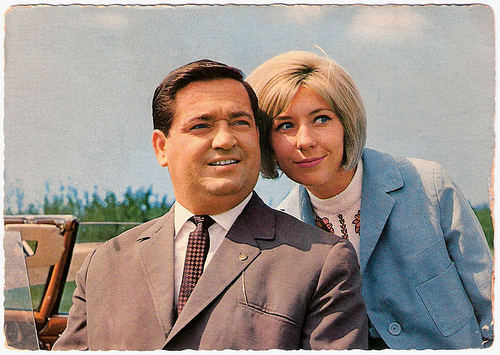
Willeke Alberti and her father, the popular ‘Tenore Napolitano’ Willy Alberti . Dutch postcard by VITA NOVA. Photo: Phonogram. Photo: Henk de Looper. Publicity card for Anker watches, imported by P.H. Bonewit, Amsterdam.

Dutch postcard by 't Sticht, Utrecht, no. 126. Photo: Philips.
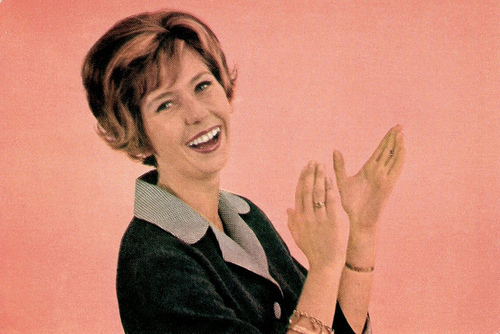
Dutch postcard by SYBA and MUVA, 1965. Photo: Phonogram. Publicity card for Aktiebureau Dousadj (Dousadj is a village in Persia) which was supported voluntarily by Willeke Alberti.
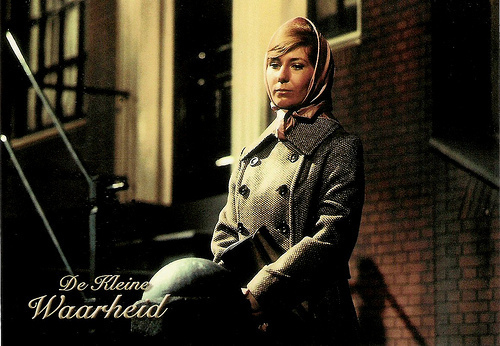
Dutch postcard by NCRV. Photo: NCRV / Instituut voor Beeld en Geluid. Publicity still for the Dutch TV series De kleine waarheid/The small truth (Willy van Hemert, 1970–1972) starring Willeke Alberti.
Teenage Idol
Willeke Alberti was born as Willy Albertina Verbrugge in Amsterdam, The Netherlands, in 1945. She is the daughter of Carel Verbrugge a.k.a. the famous Dutch entertainer and singer Willy Alberti and his wife Ria Kuiper. Willeke has a brother, Tonny.
Willeke started her career at the early age of eleven in the TV musical Duel om Barbara/Duel for Barbara (1956) and she recorded her first single in 1958 together with her father, Zeg Pappie/Tell Me Daddy.
A few years later she recorded her first solo single called Als Ik Je Zie/When I See You. Through the 1960s she had many hit recordings and she was a teenage idol.
Her first major hit was Spiegelbeeld/Mirror, Mirror (1963), the Dutch version of Tender Years by George Jones. Other #1 hits were De Winter Was Lang/The Winter Was Long (1964) and Mijn dagboek/My Diary (1964).
A fourth huge hit was Morgen ben ik de bruid/Tomorrow I’ll Be the Bride. In real life she married three times. From 1965 till 1974 she was married to Joop Oonk, guitar player in the pop group The Jumping Jewels. They have one daughter, Danielle (1968).
In 1976 she married TV producer and future TV mogul John de Mol. The couple divorced in 1980. Their son Johnny de Mol (1979) is currently a well known film actor and television personality.
Alberti had a third marriage with Danish soccer player Søren Lerby. A second son, Kaj (1983), was born from that marriage. They separated in 1990.
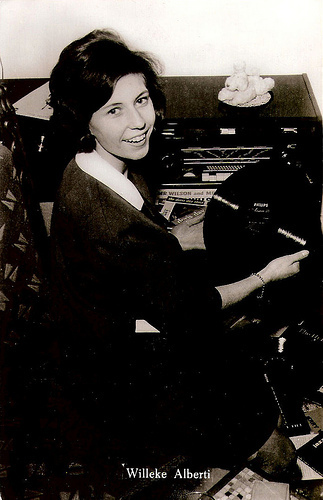
Dutch postcard by Gebr. Spanjersberg N.V., Rotterdam.
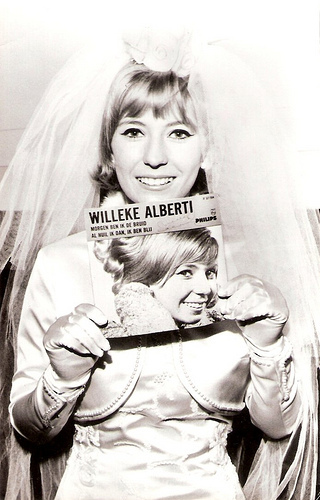
Dutch postcard by 't Sticht, Utrecht, no. AX 6518.
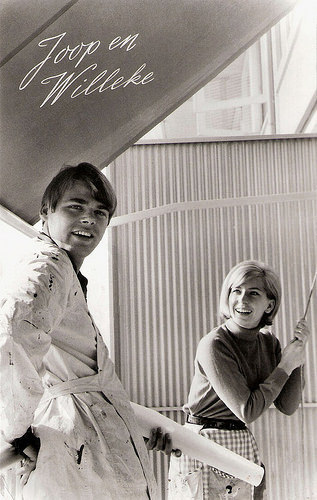
Willeke Alberti and first husband Joop Oonk. Dutch postcard by 't Sticht, Utrecht, no. AX 658.
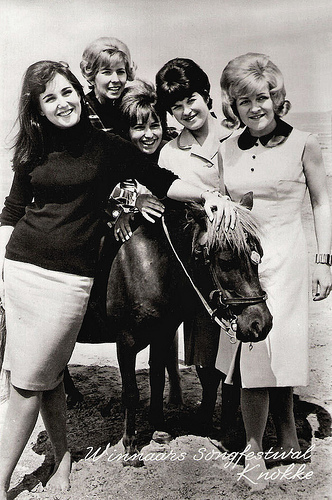
Shirley Zwerus, Willeke Alberti, Trea Dobbs, Rita Hovink, Ilonka Bilushka. Dutch postcard by Uitg. Takken, Utrecht, no. 5920. In 1964 this Dutch delegation won the Songfestival of Knokke in Belgium a.k.a. the European Cup for Vocal Recitation. Ten years later, only Willeke Alberti and Rita Hovink were still beloved performers. Hovink died in 1979.
Torch song
Willeke Alberti and her father Willy Alberti had a popular television show between 1965 and 1969. Her singing career from 1970 onwards was less active.
However Alberti still releases singles and albums at an irregular interval and plays roles in television programs and films. In 1970 she played the leading part in the popular television series De Kleine Waarheid/The Little Truth (Willy van Hemert, 1970) and won the Televizierring, the award for the best Dutch TV program of that year.
This was followed by TV films like Pygmalion (Paul Pouwels, 1974), and series like Medisch Centrum West/Medical Center West (1991).
In 1975 she played the lead in her major film Rooie Sien/Red Sien (Frans Weisz, 1975), in which she sang her torch song Telkens Weer/Times and Times Again.
Other popular films were Oom Ferdinand en de Toverdrank/Uncle Fred and the Magic Potion (Karst van der Meulen, 1974) and Feestje/Party (Paul Ruven, 1995) starring Dutch entertainer Paul de Leeuw.
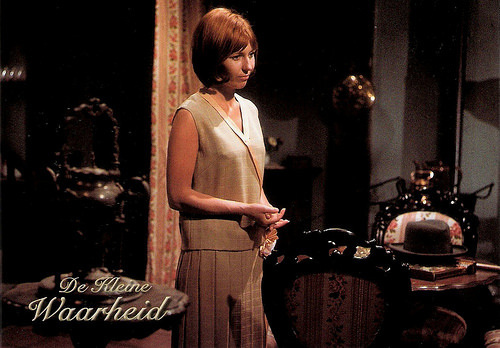
Dutch postcard by NCRV. Photo: NCRV / Instituut voor Beeld en Geluid. Publicity still for the Dutch TV series De kleine waarheid/The small truth (Willy van Hemert, 1970–1972) starring Willeke Alberti.
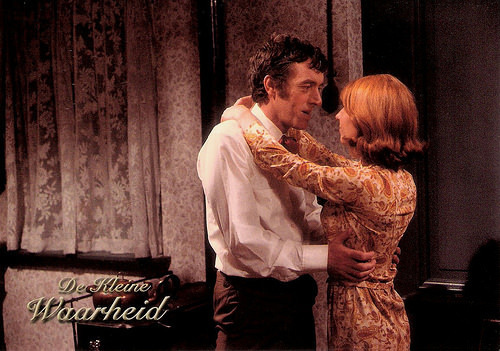
Dutch postcard by NCRV. Photo: NCRV / Instituut voor Beeld en Geluid. Publicity still for the Dutch TV series De kleine waarheid/The small truth (Willy van Hemert, 1970–1972) starring Willeke Alberti and John Leddy.
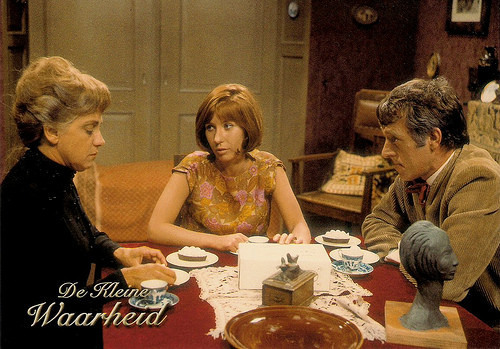
Dutch postcard by NCRV. Photo: NCRV / Instituut voor Beeld en Geluid. Publicity still for the Dutch TV series De kleine waarheid/The small truth (Willy van Hemert, 1970–1972) starring Willeke Alberti, John Leddy and Emmy Lopes Dias.
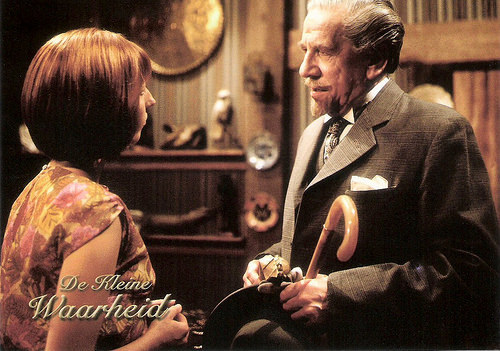
Dutch postcard by NCRV. Photo: NCRV / Instituut voor Beeld en Geluid. Publicity still for the Dutch TV series De kleine waarheid/The small truth (Willy van Hemert, 1970–1972) starring Willeke Alberti.
As long as there is love
In 1994, Willeke Alberti represented the Netherlands at the Eurovision Song Contest. Her song Waar is de Zon/Where is the Sun only claimed a meagre four points from the international juries.
That same year a musical about her life was made, simply called Willeke the Musical and it contained many of her hits. In 1995 she made a concert tour celebrating her 50th birthday.
In 2004 and 2005 Willeke played Dolly in the Dutch version of the musical Hello Dolly. In 2008 she appeared regularly in the popular soap Goede Tijden, Slechte Tijden/Good Times Bad Times, in which her son Johnny earlier started his acting career.
Through the years, Alberti has become embraced in the Netherlands as a gay icon, due to a combination of her song repertoire, her durability, and her performances in support of manifold gay and other causes.
In 2001 she established the Willeke Alberti Foundation, to structurally improve the well-being and quality of life of seniors, children and the sick in nursing homes and care homes, by organizing various cultural activities.
Recently, Willeke Alberti was seen in the cinema in the comedy Alles is familie/Family Way (Joram Lürsen, 2012) starring Carice van Houten, and as the retired Dutch queen in the family film Sinterklaas en de pepernoten chaos (Martijn van Nellestijn, 2013) with Wim Rijken as Sinterklaas .
Willeke herself certainly has not retired. After her critically acclaimed role in the stage musical De Jantjes (The Tars) (2012-2013), she is back in the theatre for a series of concerts under the title Willeke in Concert, as long as there is love.
With her son Johnny, Willeke Alberti re-recorded her father's old hit De glimlach van een kind (The smile of a child). In January 2014 it reached the Dutch charts. All proceeds from the song go to the foundation Het Vergeten Kind (The Forgotten Child).

Dutch postcard by Uitg. Takken, Utrecht, no. AX 5442, sent by mail in 1963.

Dutch postcard, no. 11-66Ph 2694. Publicity card for Philips. Autograph of Willeke Alberti.
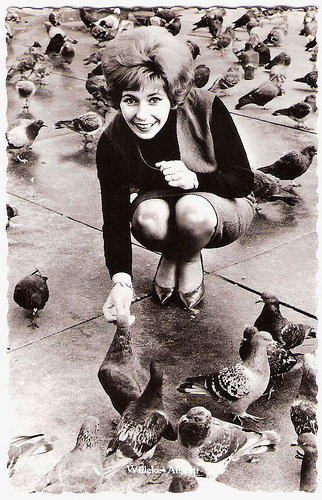
Dutch postcard, no. 1165. Photo: Phonogram.
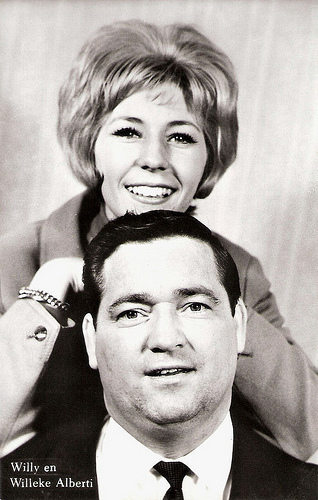
Dutch postcard by Gebr. Spanjersberg N.V. (Sparo), no. 1296. Photo: Phonogram.
Willeke Alberti sings Spiegelbeeld (1963). Source: Herman (YouTube).
Willeke Alberti sings Telkens weer from the film Rooie Sien (1975). Source: 1960Robbio (YouTube).
Willeke Alberti sings Waar is de Zon at the Eurovision Song Contest 1994. Source: Ptimadonna11 (YouTube).
Willeke Alberti and Johnny de Mol sing De glimlach van een kind (The smile of a child). Source: Het vergeten kind (YouTube).
Sources: Willeke Alberti.nl (Dutch), Wikipedia, Willeke Alberti – Official Site (Dutch), and .
For more than 50 years now, Willeke Alberti (1945) has been a very popular singer in the Netherlands. During the 1960s she was a teen idol with several #1 hits. In 1964, she was part of the Dutch delegation that won the Knokke Song festival in Belgium, but 30 years later, her participation at the 1994 Eurovision Song Contest was a disappointment. In the meanwhile the Dutch Diva starred and stars as an actress on stage, on TV and in popular Dutch films.

Willeke Alberti and her father, the popular ‘Tenore Napolitano’ Willy Alberti . Dutch postcard by VITA NOVA. Photo: Phonogram. Photo: Henk de Looper. Publicity card for Anker watches, imported by P.H. Bonewit, Amsterdam.

Dutch postcard by 't Sticht, Utrecht, no. 126. Photo: Philips.

Dutch postcard by SYBA and MUVA, 1965. Photo: Phonogram. Publicity card for Aktiebureau Dousadj (Dousadj is a village in Persia) which was supported voluntarily by Willeke Alberti.

Dutch postcard by NCRV. Photo: NCRV / Instituut voor Beeld en Geluid. Publicity still for the Dutch TV series De kleine waarheid/The small truth (Willy van Hemert, 1970–1972) starring Willeke Alberti.
Teenage Idol
Willeke Alberti was born as Willy Albertina Verbrugge in Amsterdam, The Netherlands, in 1945. She is the daughter of Carel Verbrugge a.k.a. the famous Dutch entertainer and singer Willy Alberti and his wife Ria Kuiper. Willeke has a brother, Tonny.
Willeke started her career at the early age of eleven in the TV musical Duel om Barbara/Duel for Barbara (1956) and she recorded her first single in 1958 together with her father, Zeg Pappie/Tell Me Daddy.
A few years later she recorded her first solo single called Als Ik Je Zie/When I See You. Through the 1960s she had many hit recordings and she was a teenage idol.
Her first major hit was Spiegelbeeld/Mirror, Mirror (1963), the Dutch version of Tender Years by George Jones. Other #1 hits were De Winter Was Lang/The Winter Was Long (1964) and Mijn dagboek/My Diary (1964).
A fourth huge hit was Morgen ben ik de bruid/Tomorrow I’ll Be the Bride. In real life she married three times. From 1965 till 1974 she was married to Joop Oonk, guitar player in the pop group The Jumping Jewels. They have one daughter, Danielle (1968).
In 1976 she married TV producer and future TV mogul John de Mol. The couple divorced in 1980. Their son Johnny de Mol (1979) is currently a well known film actor and television personality.
Alberti had a third marriage with Danish soccer player Søren Lerby. A second son, Kaj (1983), was born from that marriage. They separated in 1990.

Dutch postcard by Gebr. Spanjersberg N.V., Rotterdam.

Dutch postcard by 't Sticht, Utrecht, no. AX 6518.

Willeke Alberti and first husband Joop Oonk. Dutch postcard by 't Sticht, Utrecht, no. AX 658.

Shirley Zwerus, Willeke Alberti, Trea Dobbs, Rita Hovink, Ilonka Bilushka. Dutch postcard by Uitg. Takken, Utrecht, no. 5920. In 1964 this Dutch delegation won the Songfestival of Knokke in Belgium a.k.a. the European Cup for Vocal Recitation. Ten years later, only Willeke Alberti and Rita Hovink were still beloved performers. Hovink died in 1979.
Torch song
Willeke Alberti and her father Willy Alberti had a popular television show between 1965 and 1969. Her singing career from 1970 onwards was less active.
However Alberti still releases singles and albums at an irregular interval and plays roles in television programs and films. In 1970 she played the leading part in the popular television series De Kleine Waarheid/The Little Truth (Willy van Hemert, 1970) and won the Televizierring, the award for the best Dutch TV program of that year.
This was followed by TV films like Pygmalion (Paul Pouwels, 1974), and series like Medisch Centrum West/Medical Center West (1991).
In 1975 she played the lead in her major film Rooie Sien/Red Sien (Frans Weisz, 1975), in which she sang her torch song Telkens Weer/Times and Times Again.
Other popular films were Oom Ferdinand en de Toverdrank/Uncle Fred and the Magic Potion (Karst van der Meulen, 1974) and Feestje/Party (Paul Ruven, 1995) starring Dutch entertainer Paul de Leeuw.

Dutch postcard by NCRV. Photo: NCRV / Instituut voor Beeld en Geluid. Publicity still for the Dutch TV series De kleine waarheid/The small truth (Willy van Hemert, 1970–1972) starring Willeke Alberti.

Dutch postcard by NCRV. Photo: NCRV / Instituut voor Beeld en Geluid. Publicity still for the Dutch TV series De kleine waarheid/The small truth (Willy van Hemert, 1970–1972) starring Willeke Alberti and John Leddy.

Dutch postcard by NCRV. Photo: NCRV / Instituut voor Beeld en Geluid. Publicity still for the Dutch TV series De kleine waarheid/The small truth (Willy van Hemert, 1970–1972) starring Willeke Alberti, John Leddy and Emmy Lopes Dias.

Dutch postcard by NCRV. Photo: NCRV / Instituut voor Beeld en Geluid. Publicity still for the Dutch TV series De kleine waarheid/The small truth (Willy van Hemert, 1970–1972) starring Willeke Alberti.
As long as there is love
In 1994, Willeke Alberti represented the Netherlands at the Eurovision Song Contest. Her song Waar is de Zon/Where is the Sun only claimed a meagre four points from the international juries.
That same year a musical about her life was made, simply called Willeke the Musical and it contained many of her hits. In 1995 she made a concert tour celebrating her 50th birthday.
In 2004 and 2005 Willeke played Dolly in the Dutch version of the musical Hello Dolly. In 2008 she appeared regularly in the popular soap Goede Tijden, Slechte Tijden/Good Times Bad Times, in which her son Johnny earlier started his acting career.
Through the years, Alberti has become embraced in the Netherlands as a gay icon, due to a combination of her song repertoire, her durability, and her performances in support of manifold gay and other causes.
In 2001 she established the Willeke Alberti Foundation, to structurally improve the well-being and quality of life of seniors, children and the sick in nursing homes and care homes, by organizing various cultural activities.
Recently, Willeke Alberti was seen in the cinema in the comedy Alles is familie/Family Way (Joram Lürsen, 2012) starring Carice van Houten, and as the retired Dutch queen in the family film Sinterklaas en de pepernoten chaos (Martijn van Nellestijn, 2013) with Wim Rijken as Sinterklaas .
Willeke herself certainly has not retired. After her critically acclaimed role in the stage musical De Jantjes (The Tars) (2012-2013), she is back in the theatre for a series of concerts under the title Willeke in Concert, as long as there is love.
With her son Johnny, Willeke Alberti re-recorded her father's old hit De glimlach van een kind (The smile of a child). In January 2014 it reached the Dutch charts. All proceeds from the song go to the foundation Het Vergeten Kind (The Forgotten Child).

Dutch postcard by Uitg. Takken, Utrecht, no. AX 5442, sent by mail in 1963.

Dutch postcard, no. 11-66Ph 2694. Publicity card for Philips. Autograph of Willeke Alberti.

Dutch postcard, no. 1165. Photo: Phonogram.

Dutch postcard by Gebr. Spanjersberg N.V. (Sparo), no. 1296. Photo: Phonogram.
Willeke Alberti sings Spiegelbeeld (1963). Source: Herman (YouTube).
Willeke Alberti sings Telkens weer from the film Rooie Sien (1975). Source: 1960Robbio (YouTube).
Willeke Alberti sings Waar is de Zon at the Eurovision Song Contest 1994. Source: Ptimadonna11 (YouTube).
Willeke Alberti and Johnny de Mol sing De glimlach van een kind (The smile of a child). Source: Het vergeten kind (YouTube).
Sources: Willeke Alberti.nl (Dutch), Wikipedia, Willeke Alberti – Official Site (Dutch), and .
Published on September 30, 2014 23:00
September 29, 2014
Fien de la Mar
These days, Utrecht is the Dutch film city, because of the 2014
Nederlands Film Festival
. EFSP presents you the unofficial Dutch film star postcards festival, with today one of the few real film stars of the Netherlands, Fien de la Mar (1898-1965). This Dutch Diva starred in several films during the 1930s of when a Dutch Hollywood was created by German emigrants like Richard Oswald, Ludwig Berger and Max Ophüls. Fien sang a song about this curious phenomenon in the short film Hollandsch Hollywood/Dutch Hollywood (Ernst Winar, 1933).
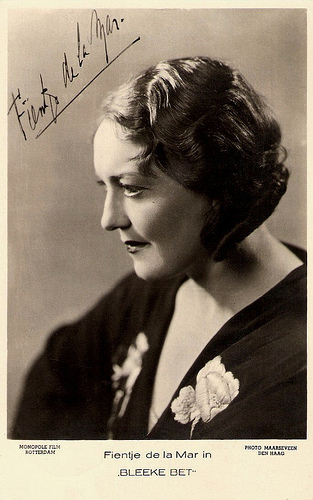
Dutch Postcard by Monopole Film, Rotterdam. Photo: Dick van Maarseveen. Publicity still for Bleeke Bet (1934).
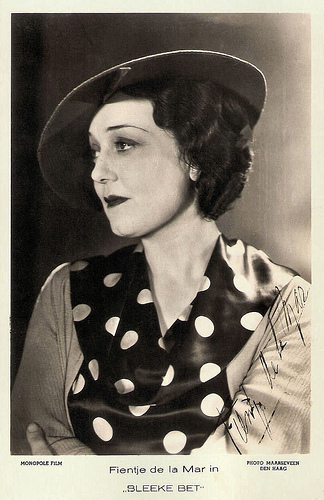
Dutch postcard by M.B. & Z. (M. Bonnist & Zonen, Amsterdam). Photo: Dick van Maarseveen, Den Haag / Monopole Film. Publicity still of Fien(tje) de la Mar in Bleeke Bet (Alex Benno, Richard Oswald, 1934). Collection: Egbert Barten.
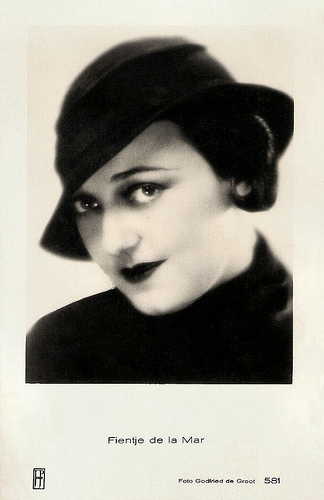
Dutch postcard by JosPe. Sent by mail in 1935. Photo: Godfried de Groot.
Capricious
Before WW II, the actress and cabaret artist was known as Fientje de la Mar. She was born in 1898 and named after Josephine de Beauharnais, the first wife of Napoleon Bonaparte.
Her grandfather Charles de la Mar was an admirer of the French emperor and had called his son Napoleon (Nap). Both were famous Dutch actors and Fien started her stage career in 1917 when she was still a school girl.
Immediately she showed talent but also a huge temper. She would become a glamorous and capricious stage star, who loved liquor and would have many lovers.
Her feature film debut was the extremely successful musical De Jantjes/The Tars (Jaap Speyer, 1934), one of the first Dutch sound films. The three title characters were played by Willy Costello , Johan Kaart and Fien's lover Jan van Ees .
Fien's second feature was Bleeke Bet (Richard Oswald, Alex Benno, 1934). In this film she sings her torch song Ik wil gelukkig zijn (I want to be happy).
Bleeke Bet (1934) was based on a popular stage melodrama by Herman Bouber, who also wrote the screenplay. His wife, Aaf Bouber played the title role, a greengrocer of the Jordaan, the old neighbourhood in Amsterdam. Bet wants her daughter Jans ( Jopie Koopman ) to marry a rich man, but Jans loves sailor Ko (the young Johannes Heesters - right on the photo).
The film was a success and would be re-issued in 1941 and 1961. In 1941 the Jewish actors like Sylvain Poons (also on the photo) were cut out of the picture by the Nazi censors. Poons as the ice-cream salesman Sally sings an evergreen in the film, IJslied (Ice-cream Song). The music was composed by emigrant Hans May and the lyrics were written by the later collaborator, Jacques van Tol.
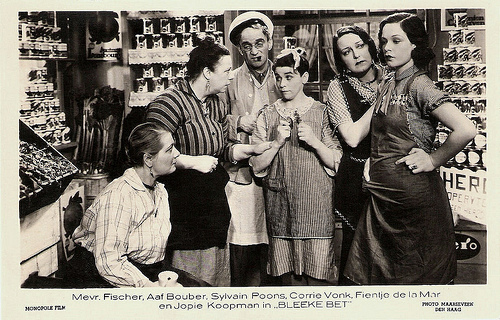
Dutch postcard by Monopole Film, Amsterdam. Photo: Maarseveen, Den Haag. Clara Vischer-Blaaser, Aaf Bouber , Sylvain Poons , Corry Vonk , Fien de la Mar and Jopie Koopman in the Dutch tragicomedy Bleeke Bet (Richard Oswald, Alex Benno, 1936).
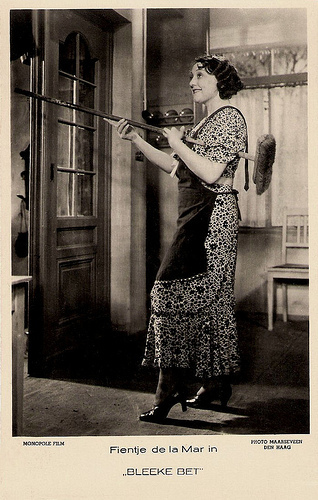
Dutch postcard by M.B. & Z. (M. Bonnist & Zonen, Amsterdam). Photo: Monopole Film / Dick van Maarseveen, Den Haag. Publicity still of Fien(tje) de la Mar in Bleeke Bet (1934).
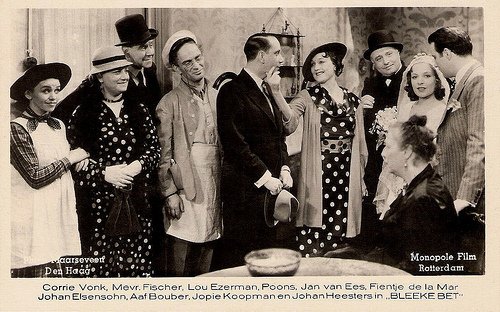
Dutch Postcard. Photo: Dick van Maarseveen. Publicity still for Bleeke Bet (1934).
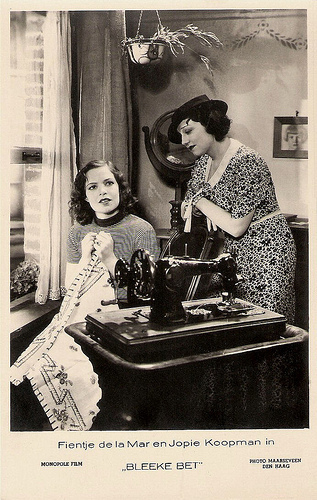
Dutch postcard by Monopole Film, Rotterdam. Photo: Dick van Maarseveen. Publicity still for Bleeke Bet (1934) with Jopie Koopman .
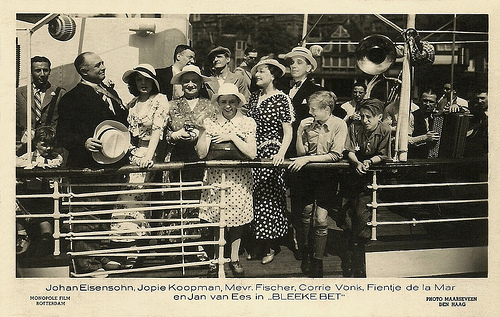
Dutch postcard by Monopole Film, Amsterdam. Photo: Maarseveen, Den Haag. Johan Elsensohn , Jopie Koopman , Clara Vischer-Blaaser, Corry Vonk , Fien de la Mar and Jan van Ees in the Dutch tragicomedy Bleeke Bet (Richard Oswald, Alex Benno, 1934).
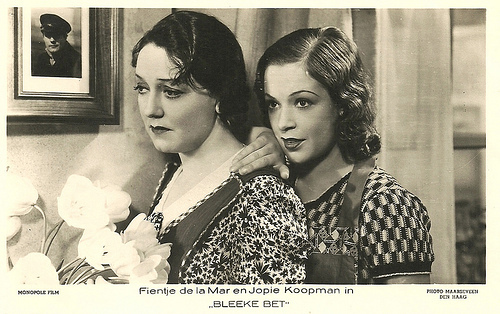
Dutch postcard by Monopole Film. Photo: Maarseveen, Den Haag. Fien(tje) de la Mar and Jopie Koopman in the tragicomedy Bleeke Bet (Alex Benno, Richard Oswald, 1934).
Tragic End
Bleeke Bet proved to be another hit and the following year Fien de la Mar would star in three more films. In the musical Op stap/On the Road (Ernst Winar, 1935) she sang a song, spectacularly accompanied by a dozen pianos.
Her co-star in this film was Frits van Dongen who later would have a Hollywood career as Philip Dorn. They also appeared together in the comedy De Big van het regiment/The Regiment's Mascot (Max Nosseck, 1935).
Her later films include Klokslag twaalf/12 'O Clock (Léo Joannon, 1936) - an alternate language version of Quand minuit sonnera (Léo Joannon, 1936) starring Marie Bell , De spooktrein/The Ghost Train (Carl Lamac, 1939) with Jan Musch , and Ergens in Nederland/Somewhere in the Netherlands (Ludwig Berger, 1940) with Lily Bouwmeester and actor-author Jan de Hartog.
A few weeks after the premiere of the latter film the Second World War started and the film was forbidden by the Nazis. In 1943 Fien refused to work for the Nazi regime and her career halted.
After the war she made a glorious stage come-back and she even had her own theatre for a while. She worked for television, but would not make any more films.
Her life ended tragically in 1965. Fien de la Mar jumped out of the window of her Amsterdam apartment and died a few days later in a hospital. Her legend is kept in an excellent biography by Jenny Pisuisse (1982), a CD and in the stage and television musical Fien (Jan Keja, 1985) with Jasperina de Jong as Fien.
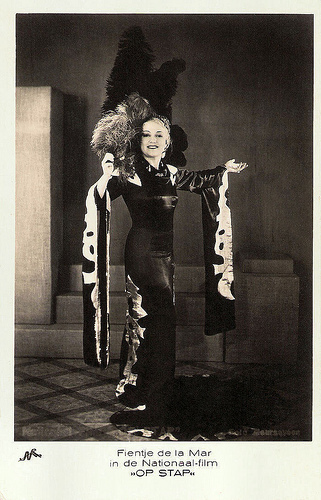
Dutch postcard by M.B. & Z. (M. Bonnist & Zonen, Amsterdam). Photo: Dick van Maarseveen, Den Haag / Nationaal Film. Publicity still of Fien(tje) de la Mar in Op stap/On the Move (Ernst Winar, 1935) .
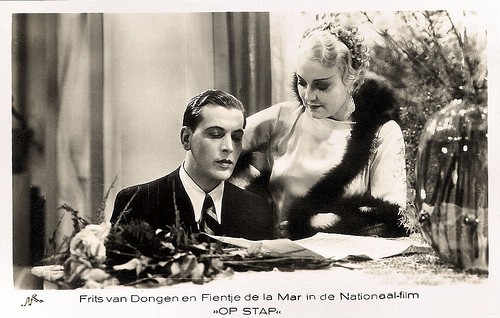
Dutch postcard by M.B. & Z. (M. Bonnist & Zonen, Amsterdam). Photo: Dick van Maarseveen, Den Haag / Nationaal Film. Publicity still for Op stap/On the Move (Ernst Winar, 1935) with Frits van Dongen .
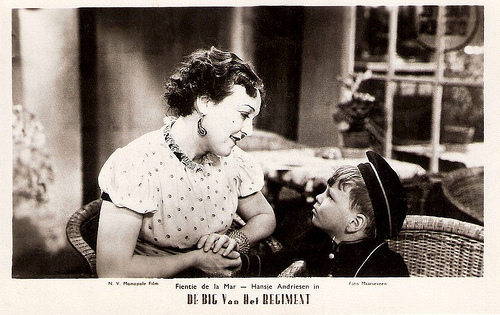
Dutch postcard by NV Monopole Film. Photo: Maarseveen. Fien(tje) de la Mar and Hansje Anderiesen (aka Jansje Andriessen and Hansje Andriesen) in De Big van het regiment (Max Nosseck, 1935).
Clip from Bleeke Bet (1934) with Fien singing Ik wil gelukkig zijn. Source: Brassens66 (YouTube).
Final scene from Op stap/On the Road (1935). Source: CaptainvonTrapp (YouTube).
Sources: Wikipedia, Wim Ibo (Huygens ING) and .

Dutch Postcard by Monopole Film, Rotterdam. Photo: Dick van Maarseveen. Publicity still for Bleeke Bet (1934).

Dutch postcard by M.B. & Z. (M. Bonnist & Zonen, Amsterdam). Photo: Dick van Maarseveen, Den Haag / Monopole Film. Publicity still of Fien(tje) de la Mar in Bleeke Bet (Alex Benno, Richard Oswald, 1934). Collection: Egbert Barten.

Dutch postcard by JosPe. Sent by mail in 1935. Photo: Godfried de Groot.
Capricious
Before WW II, the actress and cabaret artist was known as Fientje de la Mar. She was born in 1898 and named after Josephine de Beauharnais, the first wife of Napoleon Bonaparte.
Her grandfather Charles de la Mar was an admirer of the French emperor and had called his son Napoleon (Nap). Both were famous Dutch actors and Fien started her stage career in 1917 when she was still a school girl.
Immediately she showed talent but also a huge temper. She would become a glamorous and capricious stage star, who loved liquor and would have many lovers.
Her feature film debut was the extremely successful musical De Jantjes/The Tars (Jaap Speyer, 1934), one of the first Dutch sound films. The three title characters were played by Willy Costello , Johan Kaart and Fien's lover Jan van Ees .
Fien's second feature was Bleeke Bet (Richard Oswald, Alex Benno, 1934). In this film she sings her torch song Ik wil gelukkig zijn (I want to be happy).
Bleeke Bet (1934) was based on a popular stage melodrama by Herman Bouber, who also wrote the screenplay. His wife, Aaf Bouber played the title role, a greengrocer of the Jordaan, the old neighbourhood in Amsterdam. Bet wants her daughter Jans ( Jopie Koopman ) to marry a rich man, but Jans loves sailor Ko (the young Johannes Heesters - right on the photo).
The film was a success and would be re-issued in 1941 and 1961. In 1941 the Jewish actors like Sylvain Poons (also on the photo) were cut out of the picture by the Nazi censors. Poons as the ice-cream salesman Sally sings an evergreen in the film, IJslied (Ice-cream Song). The music was composed by emigrant Hans May and the lyrics were written by the later collaborator, Jacques van Tol.

Dutch postcard by Monopole Film, Amsterdam. Photo: Maarseveen, Den Haag. Clara Vischer-Blaaser, Aaf Bouber , Sylvain Poons , Corry Vonk , Fien de la Mar and Jopie Koopman in the Dutch tragicomedy Bleeke Bet (Richard Oswald, Alex Benno, 1936).

Dutch postcard by M.B. & Z. (M. Bonnist & Zonen, Amsterdam). Photo: Monopole Film / Dick van Maarseveen, Den Haag. Publicity still of Fien(tje) de la Mar in Bleeke Bet (1934).

Dutch Postcard. Photo: Dick van Maarseveen. Publicity still for Bleeke Bet (1934).

Dutch postcard by Monopole Film, Rotterdam. Photo: Dick van Maarseveen. Publicity still for Bleeke Bet (1934) with Jopie Koopman .

Dutch postcard by Monopole Film, Amsterdam. Photo: Maarseveen, Den Haag. Johan Elsensohn , Jopie Koopman , Clara Vischer-Blaaser, Corry Vonk , Fien de la Mar and Jan van Ees in the Dutch tragicomedy Bleeke Bet (Richard Oswald, Alex Benno, 1934).

Dutch postcard by Monopole Film. Photo: Maarseveen, Den Haag. Fien(tje) de la Mar and Jopie Koopman in the tragicomedy Bleeke Bet (Alex Benno, Richard Oswald, 1934).
Tragic End
Bleeke Bet proved to be another hit and the following year Fien de la Mar would star in three more films. In the musical Op stap/On the Road (Ernst Winar, 1935) she sang a song, spectacularly accompanied by a dozen pianos.
Her co-star in this film was Frits van Dongen who later would have a Hollywood career as Philip Dorn. They also appeared together in the comedy De Big van het regiment/The Regiment's Mascot (Max Nosseck, 1935).
Her later films include Klokslag twaalf/12 'O Clock (Léo Joannon, 1936) - an alternate language version of Quand minuit sonnera (Léo Joannon, 1936) starring Marie Bell , De spooktrein/The Ghost Train (Carl Lamac, 1939) with Jan Musch , and Ergens in Nederland/Somewhere in the Netherlands (Ludwig Berger, 1940) with Lily Bouwmeester and actor-author Jan de Hartog.
A few weeks after the premiere of the latter film the Second World War started and the film was forbidden by the Nazis. In 1943 Fien refused to work for the Nazi regime and her career halted.
After the war she made a glorious stage come-back and she even had her own theatre for a while. She worked for television, but would not make any more films.
Her life ended tragically in 1965. Fien de la Mar jumped out of the window of her Amsterdam apartment and died a few days later in a hospital. Her legend is kept in an excellent biography by Jenny Pisuisse (1982), a CD and in the stage and television musical Fien (Jan Keja, 1985) with Jasperina de Jong as Fien.

Dutch postcard by M.B. & Z. (M. Bonnist & Zonen, Amsterdam). Photo: Dick van Maarseveen, Den Haag / Nationaal Film. Publicity still of Fien(tje) de la Mar in Op stap/On the Move (Ernst Winar, 1935) .

Dutch postcard by M.B. & Z. (M. Bonnist & Zonen, Amsterdam). Photo: Dick van Maarseveen, Den Haag / Nationaal Film. Publicity still for Op stap/On the Move (Ernst Winar, 1935) with Frits van Dongen .

Dutch postcard by NV Monopole Film. Photo: Maarseveen. Fien(tje) de la Mar and Hansje Anderiesen (aka Jansje Andriessen and Hansje Andriesen) in De Big van het regiment (Max Nosseck, 1935).
Clip from Bleeke Bet (1934) with Fien singing Ik wil gelukkig zijn. Source: Brassens66 (YouTube).
Final scene from Op stap/On the Road (1935). Source: CaptainvonTrapp (YouTube).
Sources: Wikipedia, Wim Ibo (Huygens ING) and .
Published on September 29, 2014 23:00
September 28, 2014
Jan Musch
On the sixth day of the 2014
Nederlands Film Festival
in Utrecht, we present you in the unofficial Dutch film star postcards festival Jan Musch (1875-1960). He was one of the great stars of the Dutch theatre during the first decades of the 20th Century. In the 1930s he also starred in a few Dutch films, including the award winning drama Dood water/Dead Water (1934).
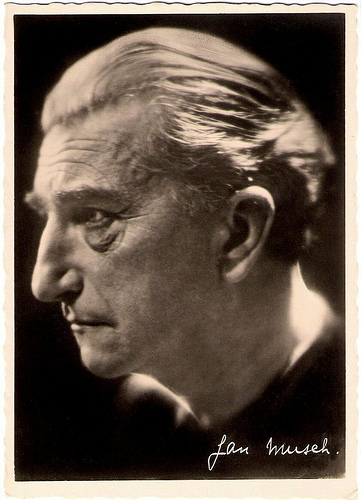
Dutch postcard by REB in the series Portrettengalerij, no. 105.
A Quiet Charm
Jan Musch was born as Johannes Petrus Musch in 1875 in De Jordaan, the heart of old Amsterdam. His father, a café owner, was offered theatre tickets for showing posters in his café. So young Jan saw a lot of stage plays and soon wanted to become an actor too.
Musch also showed talent for drawing and music. He performed as a magician, together with his friend Johan Buziau, who would later become one of the great clowns of the Dutch theatre.
Jan started his stage career in the choir of the revue De Doofpot (The Extinguisher) in the Salon des Variétés in Amsterdam. The following years he worked as an extra, singer or dresser, and also played the piano in harbour bars.
At 17, he got his first paid stage job as a servant in the classic Dutch play Spiegel der vaderlandse kooplieden (Mirror of the National Merchants). He was influenced by the naturalistic, romantic acting style of the great actor Louis Bouwmeester .
Actress Esther de Boer-Van Rijk noticed him and took care that he got an engagement at the Nederlandsche Toneelvereeniging in 1899. Under the direction of Herman Heyermans he became one of the great Dutch actors of the early 20th century in plays like Allerzielen (All Souls’ Day). His acting style changed into a quiet charm, simple and withdrawn.
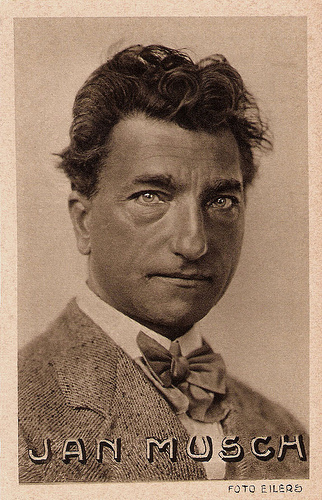
Dutch postcard in the series Hollandsche Kunstenaars (Dutch Artists). no. 1. Photo: Bernard Eilers.
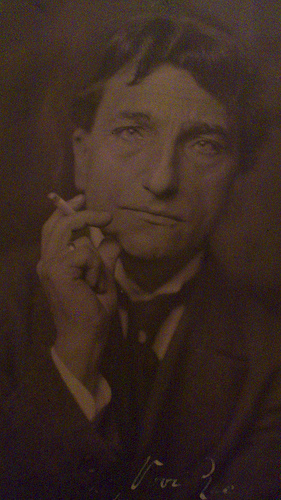
Dutch postcard. Collection: Britta K @ Flickr.
Grand Character Actor
From 1909 till 1915 Jan Musch was one of the main actors in the company of Willem Royaards, which would prove to be another main period of his stage career.
He became a grand character actor in the classic plays of Joost van den Vondel like Lucifer and Gijsbreght, and of William Shakespeare like The Merchant of Venice and A Midsummer Night’s Dream.
In 1916 he returned to Heyermans and his Nieuwe Nederl. Tooneel-Vereeniging, which performed in the Grand Théâtre in Amsterdam. Musch became the co-director.
He played the title roles in two classic Dutch plays Bredero's Spaanse Brabander (The Spanish Man of Brabant) and Pieter Langendijk’s Krelis Louwen, which he would perform again and again during the next decades.
With his great comic talent he was also an ideal interpreter of the plays by Molière, such as the miser Harpagon in L’avare (The Miser).
In the following decades Musch stayed the vital star and attraction of the different companies he worked for. In 1928 he made a successful tour in the Dutch West Indies. Privately he was reserved and never gave interviews.
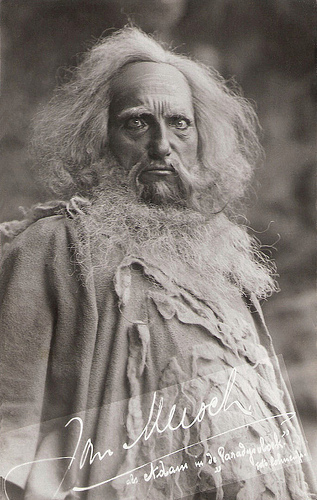
Dutch postcard. Photo: Cohnen Jr. Publicity still for the stage play De paradijsvloek (1919) by Alphons Laudy. The original production by het Schouwtooneel with Musch as Adam was a huge success in both The Netherlands and Flanders.
Underground
During the 1930s Jan Musch often worked together with the actress Else Mauhs. With her and with actor Ko Arnoldi he formed in 1933 the theatre company Het Masker (The Mask), which existed till 1936.
During this period he also appeared in a few films. He starred as a doomed fisherman of the Zuiderzee (Southern Sea) in the drama Dood water/Dead Water (Gerard Rutten, 1934) with Max Croiset. The film won an award at the Venice Film festival.
Musch also appeared in De Man zonder hart/The Man Without a Heart (Leo Joannon, 1937), and as a signal man in the thriller De spooktrein/The Ghost Train (Carl Lamac, 1939) with Fien de la Mar and Adolphe Engers .
In 1939 he retired because of ill health. In the first year of the war the Vlaamse schouwburg in Antwerpen (Antwerp), Belgium, asked him to reprise his role in Molière’s L’avare, which he did to great acclaim.
When the Nazis introduced the fascist Kulturkammer in The Netherlands, Musch refused to join. His first wife, the violinist Ans Benavente, had tried to escape through France, but was killed by the Nazis.
Musch started to perform underground, and with his second wife, actress Mary Smithuyzen, he helped the Dutch resistance. Therefore he had to flee in 1943.
After the war he started a political cabaret and performed many of his old roles on the radio. After a successful tour through Surinam in 1949 and his last film role in Myrte en de Demonen/Myrte of the Demons (Paul Bruno Schreiber, 1950) he decided to make a farewell theatre tour with L’avare in 1952.
The 77-year old Jan Musch had shone magically on the stage for more than six decades. Recovering after a stroke, he died in 1960 in his hometown Blaricum, Netherlands.
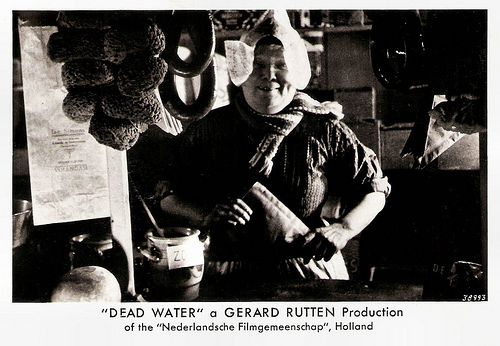
Dutch postcard, no. 38993. Photo: Nederlandse Filmgemeenschap, Holland. Publicity still for Dood water/Dead water (Gerard Rutten, 1934). Collection: Egbert Barten.
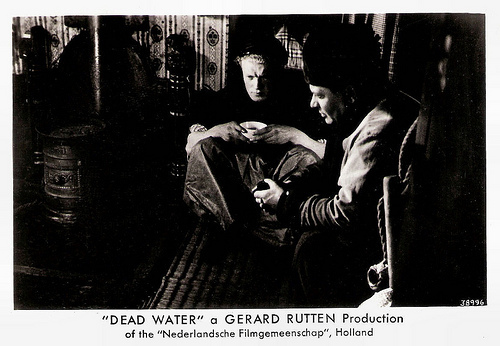
Dutch postcard, no. 38996. Photo: Nederlandse Filmgemeenschap, Holland. Publicity still for Dood water/Dead water (Gerard Rutten, 1934) with Max Croiset and Arnold Marlé. Collection: Egbert Barten.
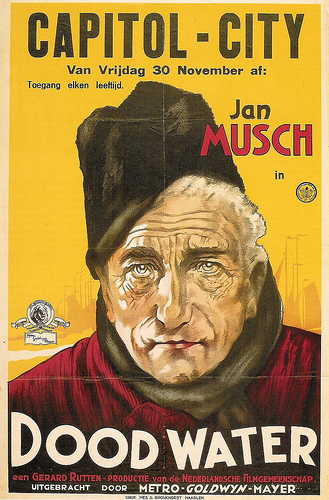
Dutch poster for the film Dood water/Dead Water (Gerard Rutten, 1934) starring Jan Musch.
Sources: Theun de Vries (DBNL) (Dutch), Wikipedia (Dutch), and .

Dutch postcard by REB in the series Portrettengalerij, no. 105.
A Quiet Charm
Jan Musch was born as Johannes Petrus Musch in 1875 in De Jordaan, the heart of old Amsterdam. His father, a café owner, was offered theatre tickets for showing posters in his café. So young Jan saw a lot of stage plays and soon wanted to become an actor too.
Musch also showed talent for drawing and music. He performed as a magician, together with his friend Johan Buziau, who would later become one of the great clowns of the Dutch theatre.
Jan started his stage career in the choir of the revue De Doofpot (The Extinguisher) in the Salon des Variétés in Amsterdam. The following years he worked as an extra, singer or dresser, and also played the piano in harbour bars.
At 17, he got his first paid stage job as a servant in the classic Dutch play Spiegel der vaderlandse kooplieden (Mirror of the National Merchants). He was influenced by the naturalistic, romantic acting style of the great actor Louis Bouwmeester .
Actress Esther de Boer-Van Rijk noticed him and took care that he got an engagement at the Nederlandsche Toneelvereeniging in 1899. Under the direction of Herman Heyermans he became one of the great Dutch actors of the early 20th century in plays like Allerzielen (All Souls’ Day). His acting style changed into a quiet charm, simple and withdrawn.

Dutch postcard in the series Hollandsche Kunstenaars (Dutch Artists). no. 1. Photo: Bernard Eilers.

Dutch postcard. Collection: Britta K @ Flickr.
Grand Character Actor
From 1909 till 1915 Jan Musch was one of the main actors in the company of Willem Royaards, which would prove to be another main period of his stage career.
He became a grand character actor in the classic plays of Joost van den Vondel like Lucifer and Gijsbreght, and of William Shakespeare like The Merchant of Venice and A Midsummer Night’s Dream.
In 1916 he returned to Heyermans and his Nieuwe Nederl. Tooneel-Vereeniging, which performed in the Grand Théâtre in Amsterdam. Musch became the co-director.
He played the title roles in two classic Dutch plays Bredero's Spaanse Brabander (The Spanish Man of Brabant) and Pieter Langendijk’s Krelis Louwen, which he would perform again and again during the next decades.
With his great comic talent he was also an ideal interpreter of the plays by Molière, such as the miser Harpagon in L’avare (The Miser).
In the following decades Musch stayed the vital star and attraction of the different companies he worked for. In 1928 he made a successful tour in the Dutch West Indies. Privately he was reserved and never gave interviews.

Dutch postcard. Photo: Cohnen Jr. Publicity still for the stage play De paradijsvloek (1919) by Alphons Laudy. The original production by het Schouwtooneel with Musch as Adam was a huge success in both The Netherlands and Flanders.
Underground
During the 1930s Jan Musch often worked together with the actress Else Mauhs. With her and with actor Ko Arnoldi he formed in 1933 the theatre company Het Masker (The Mask), which existed till 1936.
During this period he also appeared in a few films. He starred as a doomed fisherman of the Zuiderzee (Southern Sea) in the drama Dood water/Dead Water (Gerard Rutten, 1934) with Max Croiset. The film won an award at the Venice Film festival.
Musch also appeared in De Man zonder hart/The Man Without a Heart (Leo Joannon, 1937), and as a signal man in the thriller De spooktrein/The Ghost Train (Carl Lamac, 1939) with Fien de la Mar and Adolphe Engers .
In 1939 he retired because of ill health. In the first year of the war the Vlaamse schouwburg in Antwerpen (Antwerp), Belgium, asked him to reprise his role in Molière’s L’avare, which he did to great acclaim.
When the Nazis introduced the fascist Kulturkammer in The Netherlands, Musch refused to join. His first wife, the violinist Ans Benavente, had tried to escape through France, but was killed by the Nazis.
Musch started to perform underground, and with his second wife, actress Mary Smithuyzen, he helped the Dutch resistance. Therefore he had to flee in 1943.
After the war he started a political cabaret and performed many of his old roles on the radio. After a successful tour through Surinam in 1949 and his last film role in Myrte en de Demonen/Myrte of the Demons (Paul Bruno Schreiber, 1950) he decided to make a farewell theatre tour with L’avare in 1952.
The 77-year old Jan Musch had shone magically on the stage for more than six decades. Recovering after a stroke, he died in 1960 in his hometown Blaricum, Netherlands.

Dutch postcard, no. 38993. Photo: Nederlandse Filmgemeenschap, Holland. Publicity still for Dood water/Dead water (Gerard Rutten, 1934). Collection: Egbert Barten.

Dutch postcard, no. 38996. Photo: Nederlandse Filmgemeenschap, Holland. Publicity still for Dood water/Dead water (Gerard Rutten, 1934) with Max Croiset and Arnold Marlé. Collection: Egbert Barten.

Dutch poster for the film Dood water/Dead Water (Gerard Rutten, 1934) starring Jan Musch.
Sources: Theun de Vries (DBNL) (Dutch), Wikipedia (Dutch), and .
Published on September 28, 2014 23:00
September 27, 2014
Bleeke Bet (1934)
On the fourth day of the 2014 Nederlands Film Festival, it's time for a film special in our unofficial Dutch film star postcards festival. The tragi-comedy Bleeke Bet/Pale Betty (Richard Oswald, Alex Benno, 1934) was one of the first Dutch sound films, and the distributor Monopole Film ordered a series of postcards with pictures by photographer Dick van Maarseveen to promote the film. It probably worked, the film was a success in the Dutch cinemas.
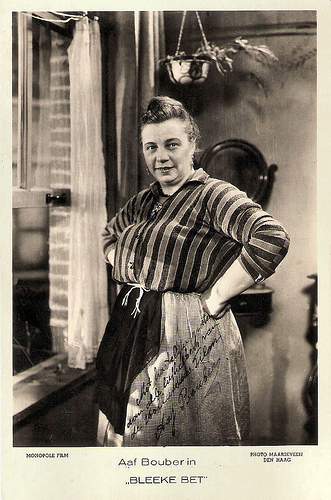
Dutch postcard by M.B. & Z. (M. Bonnist & Zonen, Amsterdam). Photo: Dick van Maarseveen, Den Haag / Monopole Film. Publicity still of Aaf Bouber in Bleeke Bet (Alex Benno, Richard Oswald, 1934). Collection: Egbert Barten.
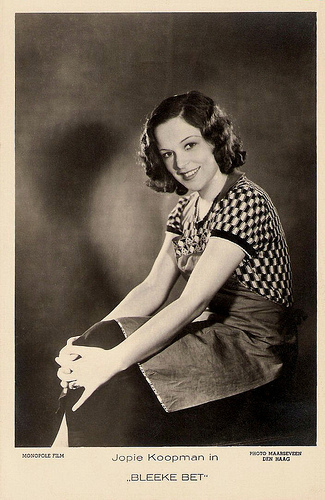
Dutch postcard by Monopole Film, Rotterdam. Photo: Dick van Maarseveen. Still of Jopie Koopman in Bleeke Bet (Alex Benno, Richard Oswald, 1934). Collection: Egbert Barten.

Dutch postcard by Monopole Film, Rotterdam. Photo: Dick van Maarseveen. Still of Fien de la Mar and Jopie Koopman in Bleeke Bet (Alex Benno, Richard Oswald, 1934).

Dutch postcard by M.B. & Z. (M. Bonnist & Zonen, Amsterdam). Photo: Monopole Film/Dick van Maarseveen, Den Haag. Publicity still of Fien(tje) de la Mar in Bleeke Bet (Alex Benno, Richard Oswald, 1934).
A greengrocer in the Jordaan
The directors of Bleeke Bet/Pale Betty (1934) were Alex Benno, who had already directed several silent Dutch films and the Austrian director, producer, and screenwriter Richard Oswald.
From 1914 on, Oswald had already made dozens of films in Weimar Germany, including the comedy Der Hauptmann von Köpenick/The Captain from Köpenick (1931) and the horror-comedy Unheimliche Geschichten/Uncanny stories (1932) starring Paul Wegener.
Being Jewish, Oswald was forced to flee Nazi Germany, first for occupied France and later emigrating to the United States.
Alex Benno had also written the screenplay for Bleeke Bet. It was based on a popular stage melodrama, written by Herman Bouber in 1917.
Benno and Bouber had already made a silent version of Bleeke Bet in 1923 with Alida van Gijtenbeek as Bet.
After the amazing box office success of the sound film De Jantjes/The Tars (Jaap Speyer, 1933), also based on a play by Bouber, Benno got the green light for a sound version of Bleeke Bet.
In the new sound version, Bouber's wife, Aaf Bouber , played the title role of Bleeke Bet, a greengrocer in the Jordaan, the old neighbourhood in the heart of Amsterdam.
Bet wants her daughter Jans ( Jopie Koopman ) to marry to the son of a dodgy businessman, but Jans loves sailor Ko (the young Johannes Heesters ).
Bet's attempts to drive them apart come to nothing but when Ko is reported lost at sea, a desperate Jans gives in to her mother's wishes. On the day of the wedding Ko turns out to be alive and just in time to take his rightful place at the altar next to Jans.
The still on the last postcard of this post by shows the happy ending with in the centre Fien de la Mar as Ka.

Dutch postcard by M.B. & Z. (M. Bonnist & Zonen, Amsterdam). Photo: Dick van Maarseveen, Den Haag / Monopole Film. Publicity still of Fien(tje) de la Mar in Bleeke Bet (1934, Alex Benno, Richard Oswald). Collection: Egbert Barten.
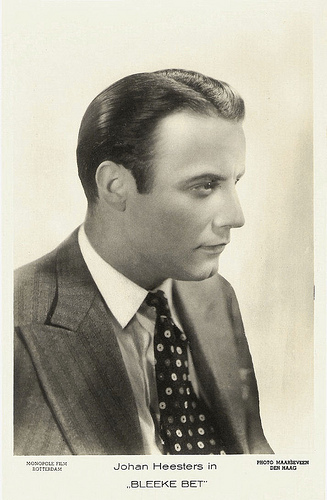
Dutch postcard by M. B. & Z. (M. Bonnist & Zonen, Amsterdam). Photo: Monopole Film, Rotterdam / Maarseveen, Den Haag. Publicity still of Johannes Heesters in Bleeke Bet (1934).
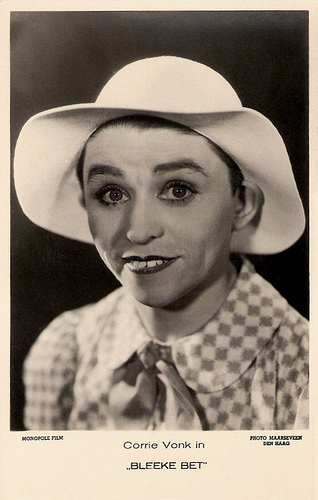
Dutch postcard by M.B. & Z. (M. Bonnist & Zonen, Amsterdam). Photo: Monopole Film / Dick van Maarseveen, Den Haag. Publicity still of Corrie Vonk in Bleeke Bet (Alex Benno, Richard Oswald, 1934).
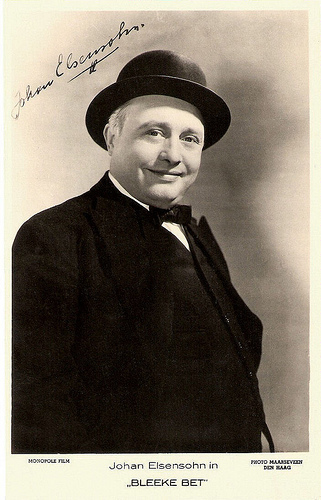
Dutch postcard by M.B. & Z. (M. Bonnist & Zonen, Amsterdam). Photo: Dick van Maarseveen, Den Haag / Monopole Film. Publicity still of Johan Elsensohn in Bleeke Bet (1934). Collection: Egbert Barten.

Dutch Postcard by Monopole Film, Rotterdam. Publicity card of Fien de la Mar in Bleeke Bet (1934). Photo: Dick van Maarseveen.
Nazi Censors
Bleeke Bet was a commercial success and would be re-issued in 1941 and 1961.
In 1941 the Jewish actors like Sylvain Poons were cut out of the picture by the Nazi censors.
Poons as the icecream salesman Sally sings an evergreen in the film, IJslied (Icecream Song).
The music was composed by emigrant Hans May and the lyrics were written by the later collaborator, Jacques van Tol.
There are more wonderful songs in the film, including Fien de la Mar's torch song Ik wil gelukkig zijn (I want to be happy).
Fien de la Mar, Sylvain Poons and Johan Elsensohn as Bet's husband got positive reviews in the Dutch newspapers for their performances. The voice of Johannes Heesters was also complimented.
However, the reviews about the film were mixed, but it did not matter to the producer: the public loved it.
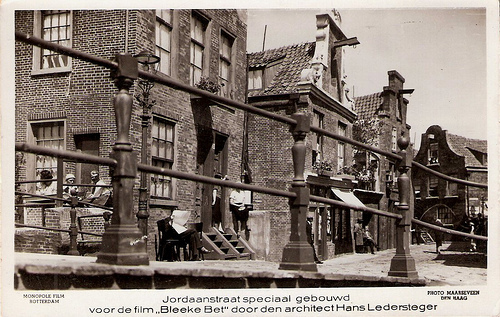
Dutch postcard by Monopole Film, Rotterdam. Photo: Dick van Maarseveen. Still of a set built for Bleeke Bet (Alex Benno, Richard Oswald, 1934), a street in the old neighbourhood De Jordaan in Amsterdam. Set designer was Hans Ledersteger. The set would be used again for several other films.

Dutch postcard by Monopole Film. Photo: Maarseveen, Den Haag. Publicity still of Fien(tje) de la Mar and Jopie Koopman in the tragicomedy Bleeke Bet (Alex Benno, Richard Oswald, 1934).

Dutch postcard by Monopole Film, Amsterdam. Photo: Maarseveen, Den Haag. Johan Elsensohn, Jopie Koopman, Clara Vischer-Blaaser, Corry Vonk, Fien de la Mar and Jan van Ees in Bleeke Bet (Richard Oswald, Alex Benno, 1934).

Dutch postcard by Monopole Film, Amsterdam. Photo: Maarseveen, Den Haag. Clara Vischer-Blaaser, Aaf Bouber, Sylvain Poons, Corry Vonk, Fien de la Mar and Jopie Koopman in Bleeke Bet (Richard Oswald, Alex Benno, 1934).
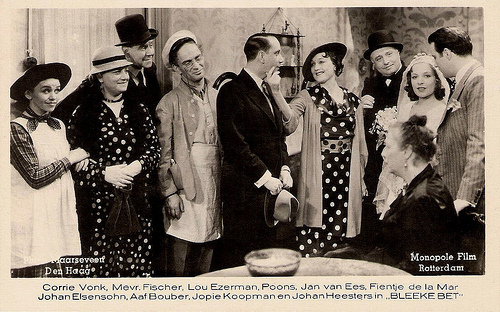
Dutch Postcard by Monopole Film, Rotterdam. Photo: Dick van Maarseveen, Den Haag (The Hague). Publicity still for Bleeke Bet (1934) with the main cast for the happy ending.
Sources: Wikipedia (Dutch and English) and IMDb.

Dutch postcard by M.B. & Z. (M. Bonnist & Zonen, Amsterdam). Photo: Dick van Maarseveen, Den Haag / Monopole Film. Publicity still of Aaf Bouber in Bleeke Bet (Alex Benno, Richard Oswald, 1934). Collection: Egbert Barten.

Dutch postcard by Monopole Film, Rotterdam. Photo: Dick van Maarseveen. Still of Jopie Koopman in Bleeke Bet (Alex Benno, Richard Oswald, 1934). Collection: Egbert Barten.

Dutch postcard by Monopole Film, Rotterdam. Photo: Dick van Maarseveen. Still of Fien de la Mar and Jopie Koopman in Bleeke Bet (Alex Benno, Richard Oswald, 1934).

Dutch postcard by M.B. & Z. (M. Bonnist & Zonen, Amsterdam). Photo: Monopole Film/Dick van Maarseveen, Den Haag. Publicity still of Fien(tje) de la Mar in Bleeke Bet (Alex Benno, Richard Oswald, 1934).
A greengrocer in the Jordaan
The directors of Bleeke Bet/Pale Betty (1934) were Alex Benno, who had already directed several silent Dutch films and the Austrian director, producer, and screenwriter Richard Oswald.
From 1914 on, Oswald had already made dozens of films in Weimar Germany, including the comedy Der Hauptmann von Köpenick/The Captain from Köpenick (1931) and the horror-comedy Unheimliche Geschichten/Uncanny stories (1932) starring Paul Wegener.
Being Jewish, Oswald was forced to flee Nazi Germany, first for occupied France and later emigrating to the United States.
Alex Benno had also written the screenplay for Bleeke Bet. It was based on a popular stage melodrama, written by Herman Bouber in 1917.
Benno and Bouber had already made a silent version of Bleeke Bet in 1923 with Alida van Gijtenbeek as Bet.
After the amazing box office success of the sound film De Jantjes/The Tars (Jaap Speyer, 1933), also based on a play by Bouber, Benno got the green light for a sound version of Bleeke Bet.
In the new sound version, Bouber's wife, Aaf Bouber , played the title role of Bleeke Bet, a greengrocer in the Jordaan, the old neighbourhood in the heart of Amsterdam.
Bet wants her daughter Jans ( Jopie Koopman ) to marry to the son of a dodgy businessman, but Jans loves sailor Ko (the young Johannes Heesters ).
Bet's attempts to drive them apart come to nothing but when Ko is reported lost at sea, a desperate Jans gives in to her mother's wishes. On the day of the wedding Ko turns out to be alive and just in time to take his rightful place at the altar next to Jans.
The still on the last postcard of this post by shows the happy ending with in the centre Fien de la Mar as Ka.

Dutch postcard by M.B. & Z. (M. Bonnist & Zonen, Amsterdam). Photo: Dick van Maarseveen, Den Haag / Monopole Film. Publicity still of Fien(tje) de la Mar in Bleeke Bet (1934, Alex Benno, Richard Oswald). Collection: Egbert Barten.

Dutch postcard by M. B. & Z. (M. Bonnist & Zonen, Amsterdam). Photo: Monopole Film, Rotterdam / Maarseveen, Den Haag. Publicity still of Johannes Heesters in Bleeke Bet (1934).

Dutch postcard by M.B. & Z. (M. Bonnist & Zonen, Amsterdam). Photo: Monopole Film / Dick van Maarseveen, Den Haag. Publicity still of Corrie Vonk in Bleeke Bet (Alex Benno, Richard Oswald, 1934).

Dutch postcard by M.B. & Z. (M. Bonnist & Zonen, Amsterdam). Photo: Dick van Maarseveen, Den Haag / Monopole Film. Publicity still of Johan Elsensohn in Bleeke Bet (1934). Collection: Egbert Barten.

Dutch Postcard by Monopole Film, Rotterdam. Publicity card of Fien de la Mar in Bleeke Bet (1934). Photo: Dick van Maarseveen.
Nazi Censors
Bleeke Bet was a commercial success and would be re-issued in 1941 and 1961.
In 1941 the Jewish actors like Sylvain Poons were cut out of the picture by the Nazi censors.
Poons as the icecream salesman Sally sings an evergreen in the film, IJslied (Icecream Song).
The music was composed by emigrant Hans May and the lyrics were written by the later collaborator, Jacques van Tol.
There are more wonderful songs in the film, including Fien de la Mar's torch song Ik wil gelukkig zijn (I want to be happy).
Fien de la Mar, Sylvain Poons and Johan Elsensohn as Bet's husband got positive reviews in the Dutch newspapers for their performances. The voice of Johannes Heesters was also complimented.
However, the reviews about the film were mixed, but it did not matter to the producer: the public loved it.

Dutch postcard by Monopole Film, Rotterdam. Photo: Dick van Maarseveen. Still of a set built for Bleeke Bet (Alex Benno, Richard Oswald, 1934), a street in the old neighbourhood De Jordaan in Amsterdam. Set designer was Hans Ledersteger. The set would be used again for several other films.

Dutch postcard by Monopole Film. Photo: Maarseveen, Den Haag. Publicity still of Fien(tje) de la Mar and Jopie Koopman in the tragicomedy Bleeke Bet (Alex Benno, Richard Oswald, 1934).

Dutch postcard by Monopole Film, Amsterdam. Photo: Maarseveen, Den Haag. Johan Elsensohn, Jopie Koopman, Clara Vischer-Blaaser, Corry Vonk, Fien de la Mar and Jan van Ees in Bleeke Bet (Richard Oswald, Alex Benno, 1934).

Dutch postcard by Monopole Film, Amsterdam. Photo: Maarseveen, Den Haag. Clara Vischer-Blaaser, Aaf Bouber, Sylvain Poons, Corry Vonk, Fien de la Mar and Jopie Koopman in Bleeke Bet (Richard Oswald, Alex Benno, 1934).

Dutch Postcard by Monopole Film, Rotterdam. Photo: Dick van Maarseveen, Den Haag (The Hague). Publicity still for Bleeke Bet (1934) with the main cast for the happy ending.
Sources: Wikipedia (Dutch and English) and IMDb.
Published on September 27, 2014 23:00
Happy 80, Brigitte Bardot!
We interrupt our Dutch Film Star Postcard Festival for breaking news.Today is BB's 80th birthday! Yes, gorgeous Brigitte Bardot was born on 28 September 1934, at 5 Place Violet in the 15th district of Paris, France. We salute her with 28 of our favourite BB postcards - without any order - we love them all. Félicitations, Mme. Bardot. Joyeux anniversaire!
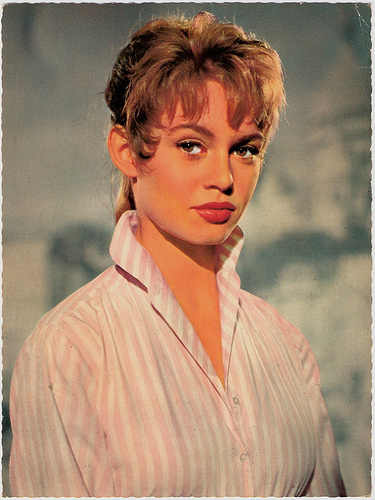
1. Dutch postcard printed by gebr. Spanjersberg N.V. Rotterdam. The first postcard I ever bought of BB.
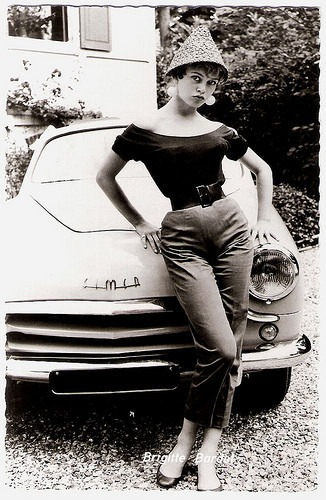
2. German postcard by Kolibri-Verlag, Minden/Westf., no. 998.
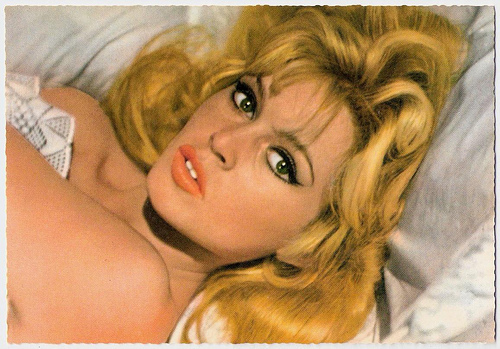
3. German postcard by ISV, no. H 60. Over 14,000 views at Flickr and 63 favourites.
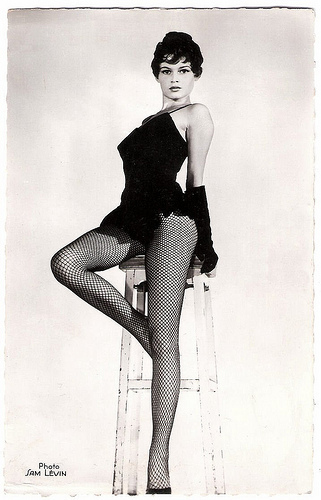
4. French postcard by Editions du Globe, Paris, no. 356. Photo: Sam Lévin.
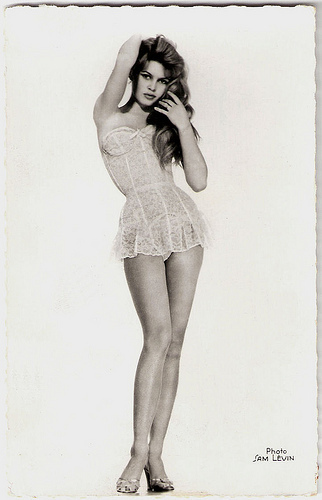
5. French postcard by Editions du Globe, Paris, no. 599. Photo: Sam Lévin.
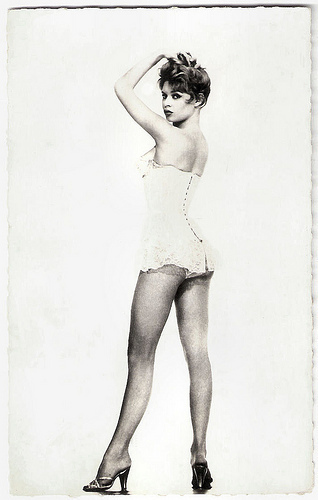
6. French postcard by Editions du Globe, Paris, no. 601. Photo: Sam Lévin.
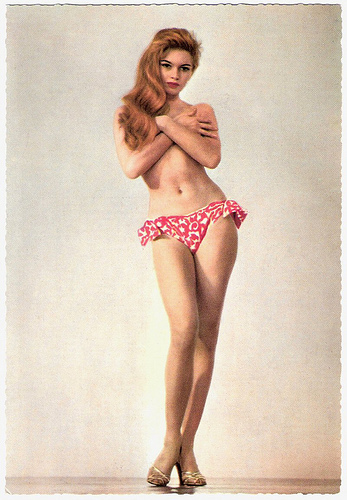
7. German postcard by ISV, Sort. IV/6. See also the same picture on this big card.
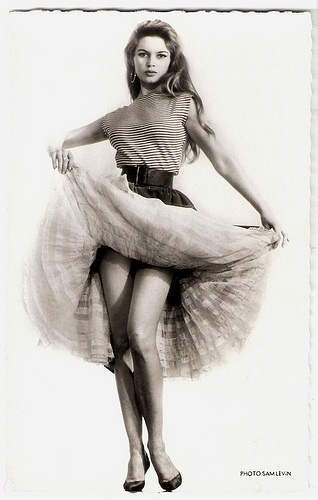
8. French postcard by Editions du Globe, Paris, no. 597. Photo: Sam Lévin. I love these long shots Lévin made of BB. She was Lévin's favourite model. This card shows why: the picture accentuates her petite figure and also shows that she knew how to pose - a bit naughty and with class.
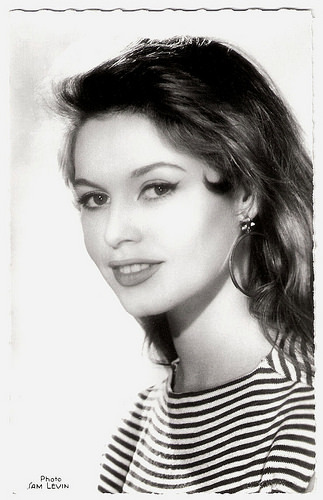
9. French postcard by Editions du Globe, Paris, no. 598. Photo: Sam Lévin.
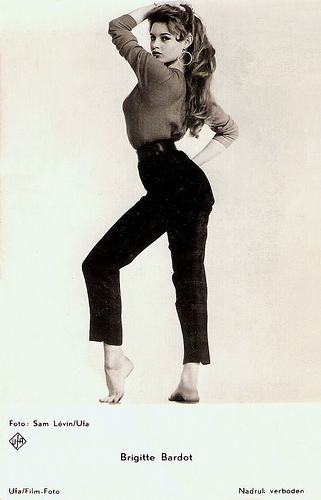
10. Dutch postcard by Gebr. Spanjersberg N.V., Rotterdam (licency holder for the Netherlands of Universum-Film Aktiengesellschaft (Ufa), Berlin-Tempelhof), nr. 4640. Sent by mail in the Netherlands in 1962. Photo: Sam Lévin/Ufa.
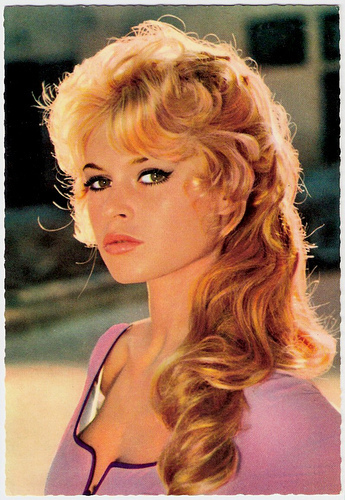
11. German postcard by ISV, no. H 11. ISV also produced this card with a photograph that must be taken at the same session, or is it even the same photo, mirrored and coloured?
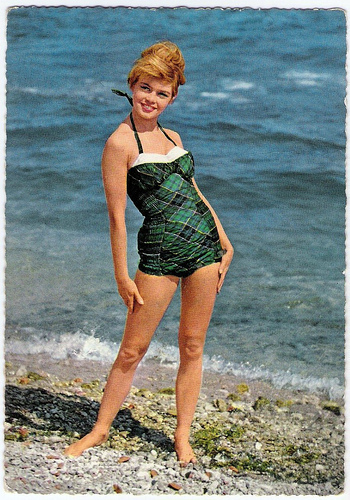
12. German postcard by Krüger, 902/166. Photo: Fried Agency.
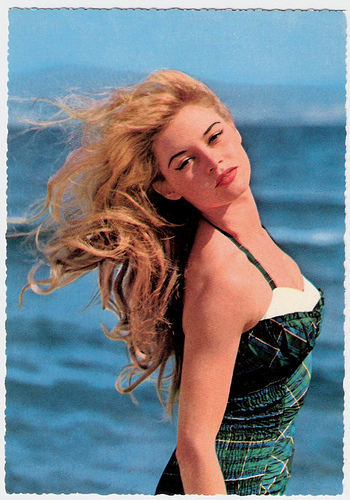
13. German postcard by Krüger, nr. 902/142. Photo: Ufa.
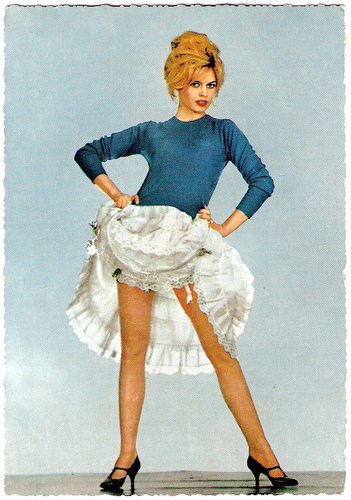
14. German postcard by Kruger.
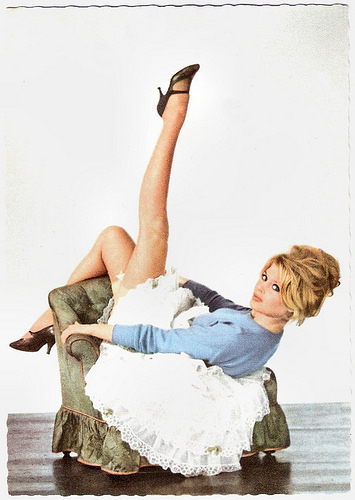
15. German postcard by Ufa, Berlin-Tempelhof, no. CK 261. Photo: Sam Lévin / Ufa.
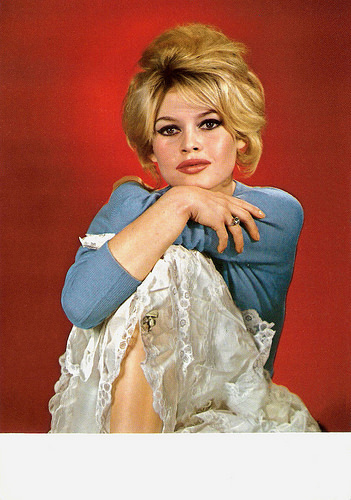
16. French postcard by Editions P.I., Paris, no. 1016. Photo: Sam Lévin.
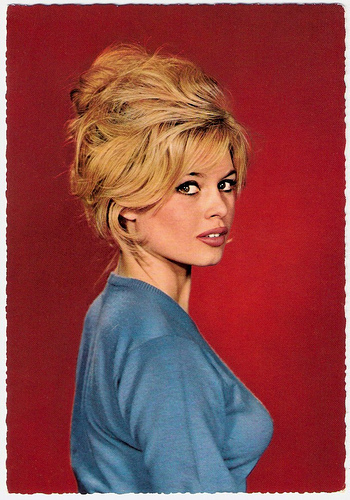
17. German postcard by Krüger, no. 902/36. Photo: Sam Lévin.
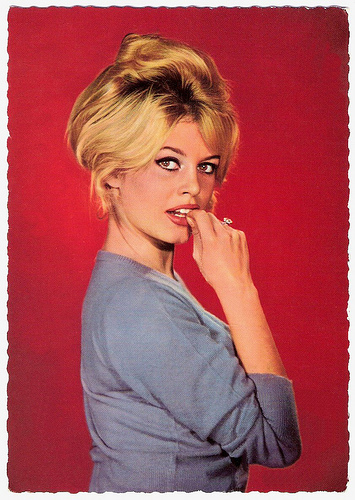
18. German postcard by Ufa (Universum-Film Aktiengesellschaft), Berlin-Tempelhof, nr. CK 346. Photo: Sam Lévin/Ufa.

19. French postcard by Editions P.I., Paris, no. 1018. Photo: Sam Lévin.
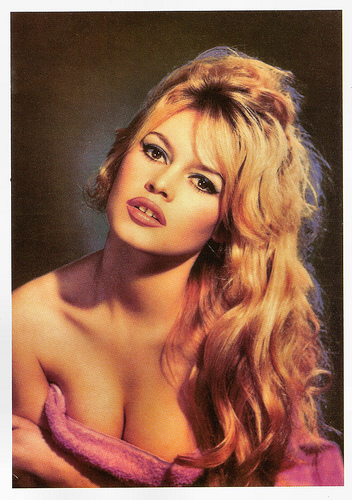
20. European postcard, no. 1154. Photo: Sam Lévin.
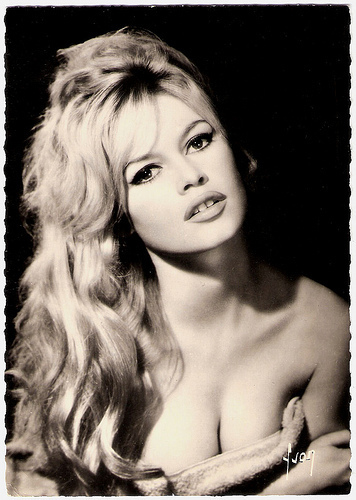
21. French postcard by Editions d'Art Yvon, Paris, no. 209. Photo: Sam Lévin.
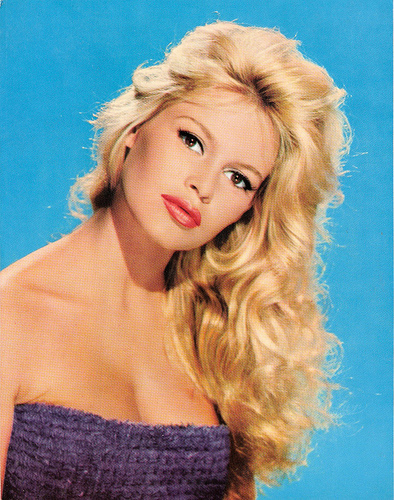
22. Big German card by ISV, no. HX 102. This is our most popular postcard at Flickr. More than 100,000 views and 129 faves.
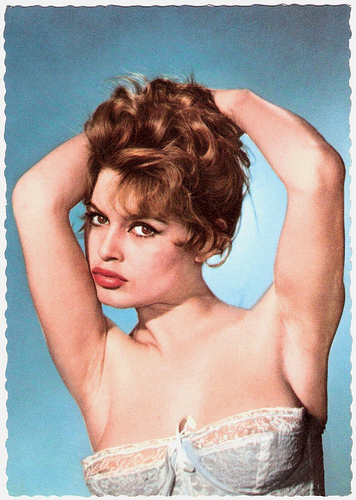
23. German postcard by UFA (Universum-Film Aktiengesellschaft, Berlin-Tempelhoff), no. CK 142. Retail price: 30 Pfg. Photo: Georg Michalke / UFA. Sam Lévin is for me the best photographer of BB, but Georg Michalke comes in second. What a sensual picture!
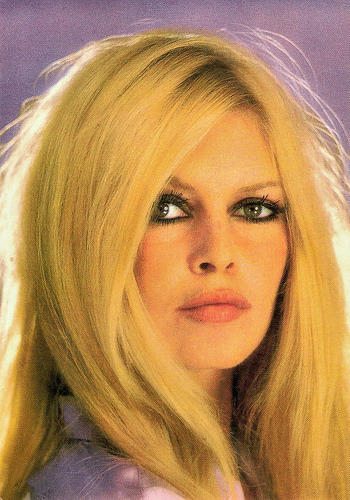
24. French postcard by E.D.U.G., no. 504. Photo: Sam Lévin.
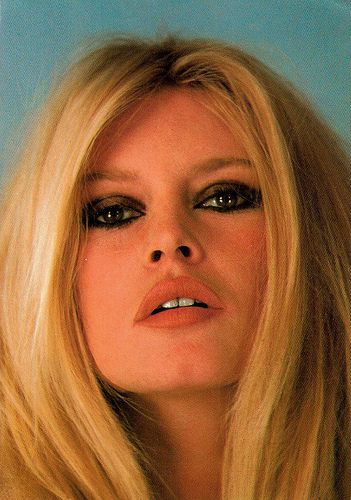
25. French postcard by Editions Lyna, Paris, no. 2085. Photo: Sam Lévin.
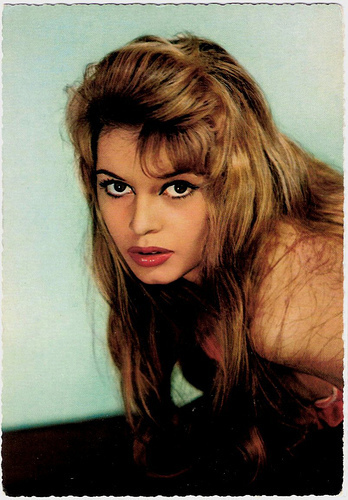
26. German postcard by Krüger / Ufa, no. 902/86. Photo: Sam Levin.
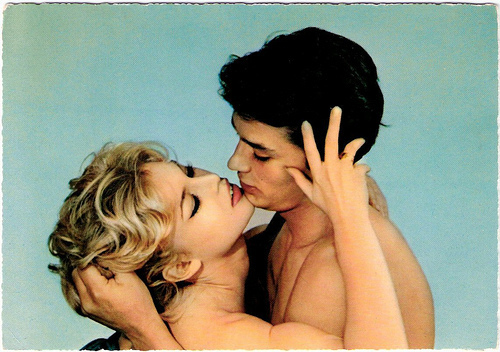
27. German postcard by Krüger, no. 902/95, ca. 1961. Photo Sam Levin. Publicity photo for Amours célèbres (Michel Boisrond, 1961). Alain Delon and Brigitte Bardot starred in the segment Agnès Bernauer.
And no. 28? Our header of course!
Oh yes, check out the new Brigitte Bardot group at Flickr! You'll love it.

1. Dutch postcard printed by gebr. Spanjersberg N.V. Rotterdam. The first postcard I ever bought of BB.

2. German postcard by Kolibri-Verlag, Minden/Westf., no. 998.

3. German postcard by ISV, no. H 60. Over 14,000 views at Flickr and 63 favourites.

4. French postcard by Editions du Globe, Paris, no. 356. Photo: Sam Lévin.

5. French postcard by Editions du Globe, Paris, no. 599. Photo: Sam Lévin.

6. French postcard by Editions du Globe, Paris, no. 601. Photo: Sam Lévin.

7. German postcard by ISV, Sort. IV/6. See also the same picture on this big card.

8. French postcard by Editions du Globe, Paris, no. 597. Photo: Sam Lévin. I love these long shots Lévin made of BB. She was Lévin's favourite model. This card shows why: the picture accentuates her petite figure and also shows that she knew how to pose - a bit naughty and with class.

9. French postcard by Editions du Globe, Paris, no. 598. Photo: Sam Lévin.

10. Dutch postcard by Gebr. Spanjersberg N.V., Rotterdam (licency holder for the Netherlands of Universum-Film Aktiengesellschaft (Ufa), Berlin-Tempelhof), nr. 4640. Sent by mail in the Netherlands in 1962. Photo: Sam Lévin/Ufa.

11. German postcard by ISV, no. H 11. ISV also produced this card with a photograph that must be taken at the same session, or is it even the same photo, mirrored and coloured?

12. German postcard by Krüger, 902/166. Photo: Fried Agency.

13. German postcard by Krüger, nr. 902/142. Photo: Ufa.

14. German postcard by Kruger.

15. German postcard by Ufa, Berlin-Tempelhof, no. CK 261. Photo: Sam Lévin / Ufa.

16. French postcard by Editions P.I., Paris, no. 1016. Photo: Sam Lévin.

17. German postcard by Krüger, no. 902/36. Photo: Sam Lévin.

18. German postcard by Ufa (Universum-Film Aktiengesellschaft), Berlin-Tempelhof, nr. CK 346. Photo: Sam Lévin/Ufa.

19. French postcard by Editions P.I., Paris, no. 1018. Photo: Sam Lévin.

20. European postcard, no. 1154. Photo: Sam Lévin.

21. French postcard by Editions d'Art Yvon, Paris, no. 209. Photo: Sam Lévin.

22. Big German card by ISV, no. HX 102. This is our most popular postcard at Flickr. More than 100,000 views and 129 faves.

23. German postcard by UFA (Universum-Film Aktiengesellschaft, Berlin-Tempelhoff), no. CK 142. Retail price: 30 Pfg. Photo: Georg Michalke / UFA. Sam Lévin is for me the best photographer of BB, but Georg Michalke comes in second. What a sensual picture!

24. French postcard by E.D.U.G., no. 504. Photo: Sam Lévin.

25. French postcard by Editions Lyna, Paris, no. 2085. Photo: Sam Lévin.

26. German postcard by Krüger / Ufa, no. 902/86. Photo: Sam Levin.

27. German postcard by Krüger, no. 902/95, ca. 1961. Photo Sam Levin. Publicity photo for Amours célèbres (Michel Boisrond, 1961). Alain Delon and Brigitte Bardot starred in the segment Agnès Bernauer.
And no. 28? Our header of course!
Oh yes, check out the new Brigitte Bardot group at Flickr! You'll love it.
Published on September 27, 2014 15:00
September 26, 2014
Herbert Joeks
It is already the fourth day of the 2014
Nederlands Film Festival
. In the unofficial Dutch film star postcards festival, the floor is for Herbert Joeks (1915-1993), who appeared in several Dutch films and TV series. For generations of Dutch kids, the frail singer and character actor became an icon in his role as the fearful Indian Klukkluk in the TV series Pipo de Clown (1958-1980).
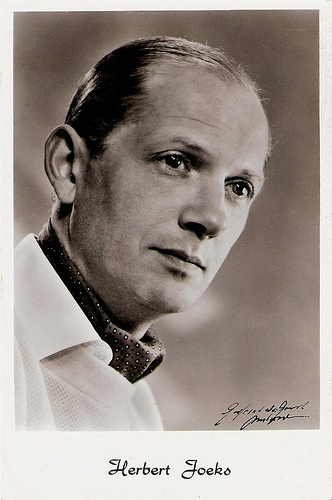
Dutch postcard. Photo: Godfried de Groot, Amsterdam.
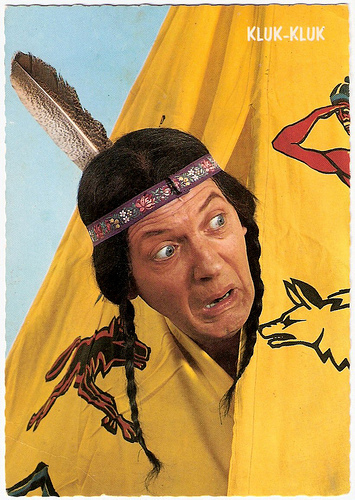
Dutch postcard by Gebr. Spanjersberg N.V., Rotterdam. Sent by mail in 1969. Photo: Herbert Joeks in Pipo de clown.
A sexton in love
Herbert Joeks was born as Herman Jozef van Hugten in Amsterdam in 1915.
He started his career in amateur theatre. In 1943 he could avoid to have to go to Germany for the Arbeitzeinsatz (forced labour) by working as a professional singer and actor for the Trianon Cabaret.
After the war he performed for Canadian soldiers and they accidentally gave him his stage name. They pronounced his surname Hugten as ‘Hughes’. In Dutch this is phonetically written as ‘Joeks’. So as Herbert Joeks he went to work for several cabaret companies and often performed for the radio.
During the 1950s he also appeared in a number of Dutch films. He played supporting parts in the comedies Sterren stralen overal/Stars Twinkle Everywhere (Gerard Rutten, 1953) as a sexton in love, and Het wonderlijke leven van Willem Parel/The Wondrous Life of Willem Parel (Gerard Rutten, 1955) as a hard-of-hearing radio director.
A huge success was the comedy Fanfare (Bert Haanstra, 1958) about two competing brass-bands in the fictional village of Brederwiede. Joeks appeared also in Haanstra’s next film, De Zaak MP/The M.P. Case (Bert Haanstra, 1960), but this comedy proved to be a huge flop.
From 1955 till 1958, Joeks was a permanent member of the acting company of the upcoming Dutch television. The first years he appeared in several TV adaptations of famous books and plays, such as Charles Dickens’ De geest van kerstmis/A Christmas Carol (1958) in which he played an acclaimed Scrooge.
With his small, frail figure, his early balding head and close mouth, and his shrill, slightly narrowed voice he usually performed the same kind of characters: a priest, a notary, a shopkeeper or just a little frightened bourgeois.
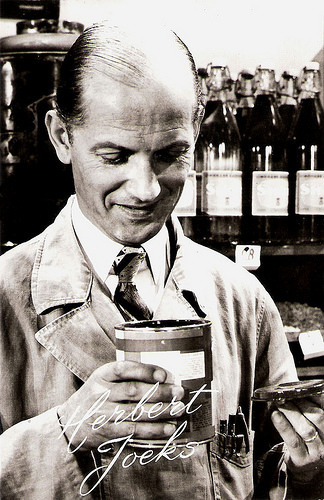
Dutch postcard by Uitgeverij Takken, Utrecht, 3793. Photo: Jutka Mol, Rome. Publicity still for Fanfare (Bert Haanstra, 1958).
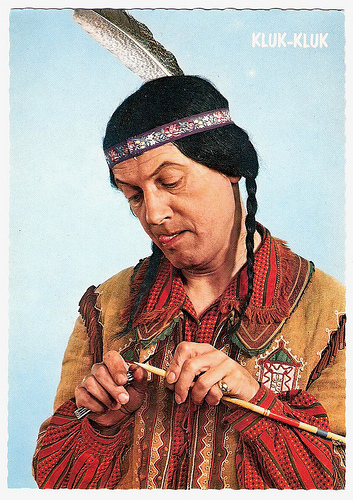
Dutch postcard by Gebr. Spanjersberg N.V., Rotterdam, no. 3. Photo: Herbert Joeks in Pipo de clown.
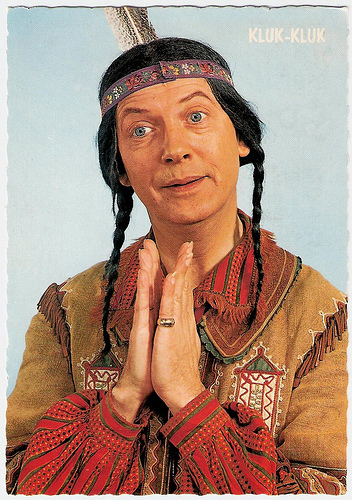
Dutch postcard by Gebr. Spanjersberg N.V., Rotterdam. Sent by mail in 1968. Photo: Herbert Joeks in Pipo de clown.
The Indian Who Always Shot Wrong
Herbert Joeks’ biggest TV success was the children’s series Pipo de clown/Pipo the Clown (Henk Barnard a.o., 1958-1980). It was an exciting, fairy-tale like adventure about Pipo the clown (Cor Witschge) and his wife Mamalou.
Pipo and Mamalou were travelling around in a 19th century circus wagon, pulled by a single mule called Nononono. They and their friends were faced with all sorts of problems and dangers.
Their best friend was the fearful Indian Klukkluk, who always shot wrong. As Klukkluk he conquered the hearts of many generations of children. He spoke a self-made language and introduced new words to the Dutch language.
In 1975 Joeks also appeared as Klukkluk in the cinema in the feature film Pipo en de piraten van toen/Pipo and the Pirates of the Past (Kees van Eyk, 1975), filmed on the Caribbean island of Aruba.
The last episode (number 118) of the series was shown in 1980. Meanwhile Joeks appeared in several other TV films and series. During the 1960s he played supporting parts in such children’s series as Bas Boterbloem/Bas Butterflower (Gerrit den Brabander a.o., 1960) and De Avonturen van Okkie Trooy/The Adventures of Okkie Trooy (Bram van Erkel, 1962).
Joeks also appeared in comedy series like Herrie om Harrie/Here’s Harry (Willy van Hemert, 1963) and Tot de dood on scheidt/Till Death Do Us Part (1970), and in the popular drama series Joop ter Heul (1968), Klaverweide/Clover Meadow (1973) and Hollands Glorie/Dutch Glory (Walter van der Kamp, 1975) based on the 1940 novel by Jan de Hartog.
However he is best remembered for his work in children’s series. Later series were Kunt u mij de weg naar Hamelen vertellen, meneer?/Could You Tell Me the Road to Hamelin, Sir? (1972), and Familie Oudenrijn/The Oudenrijn Family (Bob Spiers, Wouter Stips, 1985).
His last film role was as a patient in the comedy De Boezemvriend/The Bossom Buddy (Dimitri Frenkel Frank, 1982) starring Dutch comedian André van Duin, and his final TV role was also as a patient in the soap Medisch Centrum West/Medical Centre West (1991).
Sadly, he became in private a patient too. In 1993, Herbert Joeks died in Amsterdam of complications of cancer, at the age of 77. He was married to Fransje van Balkom and they had a daughter, Madeleine.
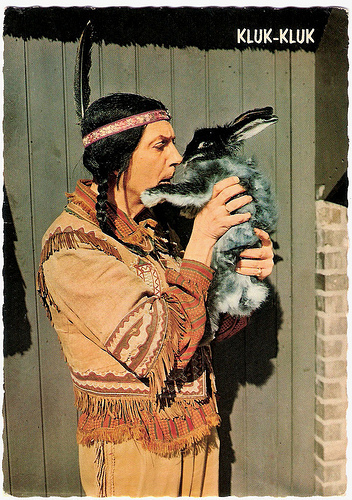
Dutch postcard by Gebr. Spanjersberg N.V., Rotterdam. Sent by mail in 1969. Photo: Herbert Joeks in Pipo de clown.
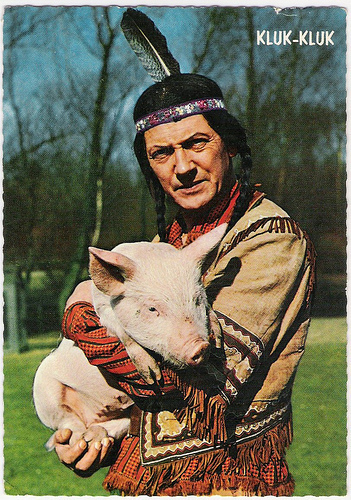
Dutch postcard. Photo: Herbert Joeks in Pipo de clown.
Sources: A.J.C.M. Gabriëls (Huygens ING), Wikipedia (Dutch) and .

Dutch postcard. Photo: Godfried de Groot, Amsterdam.

Dutch postcard by Gebr. Spanjersberg N.V., Rotterdam. Sent by mail in 1969. Photo: Herbert Joeks in Pipo de clown.
A sexton in love
Herbert Joeks was born as Herman Jozef van Hugten in Amsterdam in 1915.
He started his career in amateur theatre. In 1943 he could avoid to have to go to Germany for the Arbeitzeinsatz (forced labour) by working as a professional singer and actor for the Trianon Cabaret.
After the war he performed for Canadian soldiers and they accidentally gave him his stage name. They pronounced his surname Hugten as ‘Hughes’. In Dutch this is phonetically written as ‘Joeks’. So as Herbert Joeks he went to work for several cabaret companies and often performed for the radio.
During the 1950s he also appeared in a number of Dutch films. He played supporting parts in the comedies Sterren stralen overal/Stars Twinkle Everywhere (Gerard Rutten, 1953) as a sexton in love, and Het wonderlijke leven van Willem Parel/The Wondrous Life of Willem Parel (Gerard Rutten, 1955) as a hard-of-hearing radio director.
A huge success was the comedy Fanfare (Bert Haanstra, 1958) about two competing brass-bands in the fictional village of Brederwiede. Joeks appeared also in Haanstra’s next film, De Zaak MP/The M.P. Case (Bert Haanstra, 1960), but this comedy proved to be a huge flop.
From 1955 till 1958, Joeks was a permanent member of the acting company of the upcoming Dutch television. The first years he appeared in several TV adaptations of famous books and plays, such as Charles Dickens’ De geest van kerstmis/A Christmas Carol (1958) in which he played an acclaimed Scrooge.
With his small, frail figure, his early balding head and close mouth, and his shrill, slightly narrowed voice he usually performed the same kind of characters: a priest, a notary, a shopkeeper or just a little frightened bourgeois.

Dutch postcard by Uitgeverij Takken, Utrecht, 3793. Photo: Jutka Mol, Rome. Publicity still for Fanfare (Bert Haanstra, 1958).

Dutch postcard by Gebr. Spanjersberg N.V., Rotterdam, no. 3. Photo: Herbert Joeks in Pipo de clown.

Dutch postcard by Gebr. Spanjersberg N.V., Rotterdam. Sent by mail in 1968. Photo: Herbert Joeks in Pipo de clown.
The Indian Who Always Shot Wrong
Herbert Joeks’ biggest TV success was the children’s series Pipo de clown/Pipo the Clown (Henk Barnard a.o., 1958-1980). It was an exciting, fairy-tale like adventure about Pipo the clown (Cor Witschge) and his wife Mamalou.
Pipo and Mamalou were travelling around in a 19th century circus wagon, pulled by a single mule called Nononono. They and their friends were faced with all sorts of problems and dangers.
Their best friend was the fearful Indian Klukkluk, who always shot wrong. As Klukkluk he conquered the hearts of many generations of children. He spoke a self-made language and introduced new words to the Dutch language.
In 1975 Joeks also appeared as Klukkluk in the cinema in the feature film Pipo en de piraten van toen/Pipo and the Pirates of the Past (Kees van Eyk, 1975), filmed on the Caribbean island of Aruba.
The last episode (number 118) of the series was shown in 1980. Meanwhile Joeks appeared in several other TV films and series. During the 1960s he played supporting parts in such children’s series as Bas Boterbloem/Bas Butterflower (Gerrit den Brabander a.o., 1960) and De Avonturen van Okkie Trooy/The Adventures of Okkie Trooy (Bram van Erkel, 1962).
Joeks also appeared in comedy series like Herrie om Harrie/Here’s Harry (Willy van Hemert, 1963) and Tot de dood on scheidt/Till Death Do Us Part (1970), and in the popular drama series Joop ter Heul (1968), Klaverweide/Clover Meadow (1973) and Hollands Glorie/Dutch Glory (Walter van der Kamp, 1975) based on the 1940 novel by Jan de Hartog.
However he is best remembered for his work in children’s series. Later series were Kunt u mij de weg naar Hamelen vertellen, meneer?/Could You Tell Me the Road to Hamelin, Sir? (1972), and Familie Oudenrijn/The Oudenrijn Family (Bob Spiers, Wouter Stips, 1985).
His last film role was as a patient in the comedy De Boezemvriend/The Bossom Buddy (Dimitri Frenkel Frank, 1982) starring Dutch comedian André van Duin, and his final TV role was also as a patient in the soap Medisch Centrum West/Medical Centre West (1991).
Sadly, he became in private a patient too. In 1993, Herbert Joeks died in Amsterdam of complications of cancer, at the age of 77. He was married to Fransje van Balkom and they had a daughter, Madeleine.

Dutch postcard by Gebr. Spanjersberg N.V., Rotterdam. Sent by mail in 1969. Photo: Herbert Joeks in Pipo de clown.

Dutch postcard. Photo: Herbert Joeks in Pipo de clown.
Sources: A.J.C.M. Gabriëls (Huygens ING), Wikipedia (Dutch) and .
Published on September 26, 2014 23:00
September 25, 2014
Linda van Dyck
Today is the third day of the
Nederlands Film Festival
, and EFSP presents you another post in the unofficial Dutch film star postcards festival. Dutch stage actress Linda van Dyck (1948) appeared in a dozen Dutch and Belgian films, which were sometimes very successful in the low countries. She started as a pop singer and songwriter in the sixties. Van Dyck also worked for television both in the Netherlands and in Sweden, where she lived for some years in the late 1960s and early 1970s.
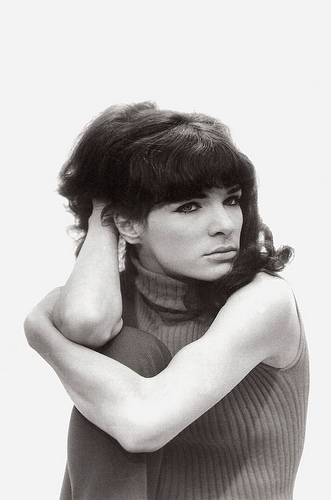
Dutch postcard. Photo: Funckler Grammofoonplaten.
Boo and the Booboo's
Linda van Dyck (sometimes written as Dijck) was born as Linda Marianne de Hartogh in Amsterdam, The Netherlands, in 1948. She was the daughter of the actors Leo de Hartogh and Teddy Schaank.
Her stepfather was the legendary Dutch stage actor Ko van Dijk, with whom she made her stage debut in 1959 in De vader (The Father) by August Strindberg.
In 1966 she appeared in two Dutch feature films: the murder mystery 10:32/10:32 in the Morning (Arthur Dreifuss, 1966) starring Linda Christian , and Het Gangstermeisje/A Gangstergirl (Frans Weisz, 1966) with Paolo Graziosi, Kitty Courbois and Gian Maria Volonté.
In the 1960s she was best known as the singer of the band Boo and the Booboo's, for which she also wrote song texts. Her last single as a (solo) singer and also her biggest hit was Seduction Song (1969).
She decided to become an actress and moved to Sweden where she worked for television for a period of five years.
The Dutch beat band Boo and the Booboo's featuring Linda van Dyck play Stengun (1966). Source: Funnyfreakparade (YouTube).
The second solo single by Linda van Dyck, Baby, What Am I Doing (1967). Source: Erikavburen (YouTube).
A Sensual Aunt
Linda van Dyck returned to the Netherlands in 1973 and appeared in several popular TV series and stage productions.
In 1979 she played a small part in the film Tiro (Jacob Bijl, 1979) with Kitty Courbois.
A huge success was her role as the sensual aunt Coleta in the coming of age drama Twee vorstinnen en een vorst/Two Queens and a King (Otto Jongerius, 1981) with Eric Clerckx as the young protagonist and Kitty Courbois as his mother.
Another success was her part in the drama Ademloos/Breathless (Mady Saks, 1982) with Monique van de Ven. For these two roles Linda van Dyck was proclaimed Best Dutch film actress in 1982.
Another popular local hit was Ciske de Rat/Ciske the Rat (Guido Pieters, 1984) featuring child star Danny de Munk and Willeke van Ammelrooy as his nasty mother. Van Dyck played again the aunt of the protagonist.
In between these films she appeared on stage and in such prestigious TV dramas as Willem van Oranje/William of Orange (Walter van der Kamp, 1984) starring Jeroen Krabbé .
Other films in which she appeared were the thriller De Grens/The Border (Leon de Winter, 1984) with Johan Leysen and Angela Winkler, and the war film In de schaduw van de overwinning/In the Shadow of the Victory (1986) starring Jeroen Krabbé.
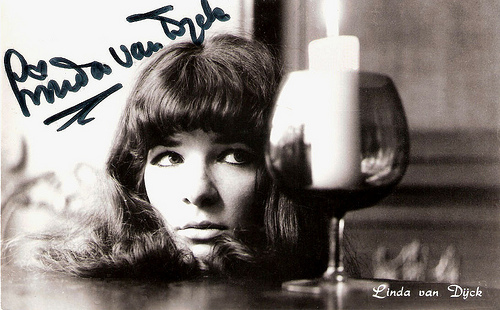
Dutch postcard. Promocard by International Artists, Hilversum.
Knight
During the 1990s, Linda van Dyck only incidentally appeared in films. She played a supporting part in the Belgian-French-Dutch production Daens/Priest Daens (Stijn Conincx, 1994), based on the novel by Louis Paul Boon and featuring Jan Decleir.
A surprise was the award winning TV film Suzy Q (Martin Koolhoven, 1999), about a weekend in the life of a bizarre family in the sixties. Van Dyck played the mother and her children were played by the upcoming stars Carice van Houten, Roeland Fernhout and Michiel Huisman.
Her later films included Magonia (Ineke Smits, 2001) with Ramsey Nasr, the swashbuckler Floris (Jean van de Velde, 2004) featuring Michiel Huisman, and the multicultural comedy Het schnitzelparadijs/Schnitzel Paradise (Martin Koolhoven, 2005).
Her greatest successes were in the Dutch theatre where she starred in such popular and acclaimed productions as De dood en het meisje (Death and the Maiden) (2003), Herfstsonate (Autumn Sonata) (2005-2006), Nacht, Moeder (Night, Mother) (2006-2007) and Una Giornata Particolare (2007-2008).
In 2010 Linda van Dyck received a Royal order: Ridder in de orde van de Nederlandse Leeuw (Knight in the Order of the Dutch Lion).
Linda van Dyck is married to Jaap Nolst Trenité, with whom she has a son, Jamie Maxim Nolst Trenité (1990).
Linda Van Dyck sings You Don't Love Me (1968). Source: Oldies1 (YouTube).
Trailer of Het schnitzelparadijs/Schnitzel Paradise (2005). Source: KnipFilm (YouTube).
Sources: Wikipedia (Dutch), and .

Dutch postcard. Photo: Funckler Grammofoonplaten.
Boo and the Booboo's
Linda van Dyck (sometimes written as Dijck) was born as Linda Marianne de Hartogh in Amsterdam, The Netherlands, in 1948. She was the daughter of the actors Leo de Hartogh and Teddy Schaank.
Her stepfather was the legendary Dutch stage actor Ko van Dijk, with whom she made her stage debut in 1959 in De vader (The Father) by August Strindberg.
In 1966 she appeared in two Dutch feature films: the murder mystery 10:32/10:32 in the Morning (Arthur Dreifuss, 1966) starring Linda Christian , and Het Gangstermeisje/A Gangstergirl (Frans Weisz, 1966) with Paolo Graziosi, Kitty Courbois and Gian Maria Volonté.
In the 1960s she was best known as the singer of the band Boo and the Booboo's, for which she also wrote song texts. Her last single as a (solo) singer and also her biggest hit was Seduction Song (1969).
She decided to become an actress and moved to Sweden where she worked for television for a period of five years.
The Dutch beat band Boo and the Booboo's featuring Linda van Dyck play Stengun (1966). Source: Funnyfreakparade (YouTube).
The second solo single by Linda van Dyck, Baby, What Am I Doing (1967). Source: Erikavburen (YouTube).
A Sensual Aunt
Linda van Dyck returned to the Netherlands in 1973 and appeared in several popular TV series and stage productions.
In 1979 she played a small part in the film Tiro (Jacob Bijl, 1979) with Kitty Courbois.
A huge success was her role as the sensual aunt Coleta in the coming of age drama Twee vorstinnen en een vorst/Two Queens and a King (Otto Jongerius, 1981) with Eric Clerckx as the young protagonist and Kitty Courbois as his mother.
Another success was her part in the drama Ademloos/Breathless (Mady Saks, 1982) with Monique van de Ven. For these two roles Linda van Dyck was proclaimed Best Dutch film actress in 1982.
Another popular local hit was Ciske de Rat/Ciske the Rat (Guido Pieters, 1984) featuring child star Danny de Munk and Willeke van Ammelrooy as his nasty mother. Van Dyck played again the aunt of the protagonist.
In between these films she appeared on stage and in such prestigious TV dramas as Willem van Oranje/William of Orange (Walter van der Kamp, 1984) starring Jeroen Krabbé .
Other films in which she appeared were the thriller De Grens/The Border (Leon de Winter, 1984) with Johan Leysen and Angela Winkler, and the war film In de schaduw van de overwinning/In the Shadow of the Victory (1986) starring Jeroen Krabbé.

Dutch postcard. Promocard by International Artists, Hilversum.
Knight
During the 1990s, Linda van Dyck only incidentally appeared in films. She played a supporting part in the Belgian-French-Dutch production Daens/Priest Daens (Stijn Conincx, 1994), based on the novel by Louis Paul Boon and featuring Jan Decleir.
A surprise was the award winning TV film Suzy Q (Martin Koolhoven, 1999), about a weekend in the life of a bizarre family in the sixties. Van Dyck played the mother and her children were played by the upcoming stars Carice van Houten, Roeland Fernhout and Michiel Huisman.
Her later films included Magonia (Ineke Smits, 2001) with Ramsey Nasr, the swashbuckler Floris (Jean van de Velde, 2004) featuring Michiel Huisman, and the multicultural comedy Het schnitzelparadijs/Schnitzel Paradise (Martin Koolhoven, 2005).
Her greatest successes were in the Dutch theatre where she starred in such popular and acclaimed productions as De dood en het meisje (Death and the Maiden) (2003), Herfstsonate (Autumn Sonata) (2005-2006), Nacht, Moeder (Night, Mother) (2006-2007) and Una Giornata Particolare (2007-2008).
In 2010 Linda van Dyck received a Royal order: Ridder in de orde van de Nederlandse Leeuw (Knight in the Order of the Dutch Lion).
Linda van Dyck is married to Jaap Nolst Trenité, with whom she has a son, Jamie Maxim Nolst Trenité (1990).
Linda Van Dyck sings You Don't Love Me (1968). Source: Oldies1 (YouTube).
Trailer of Het schnitzelparadijs/Schnitzel Paradise (2005). Source: KnipFilm (YouTube).
Sources: Wikipedia (Dutch), and .
Published on September 25, 2014 23:00
September 24, 2014
Ery Bos
Today is the second day of the
Nederlands Film Festival
(24 September - 3 October 2014) and EFSP presents another post in the unofficial Dutch Film Star Postcards Festival. Sweet and elegant Ery Bos (1908-2005) was a Dutch-German actress, who had a short but productive film career in the early German sound film. In only three years, from 1932 till 1934, she took part in a dozen films.
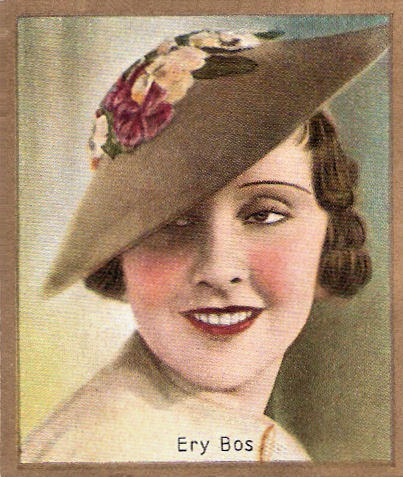
German collectors card by Salem Zigaretten in the series Bunte Filmbilder, no. 269 (in a series of 275). Photo: Dührkoop / Ross Verlag.
Solo Dancer
Erika Bos was born in Berlin, Germany in 1908 (some sources say 1910). She was the daughter of Dutch composer and pianist Coenraad V. Bos.
At the age of 10, she already had dance classes. She first attended public attention as a solo dancer in the 1920s and at 17 she was already a solo dancer in the city of Dortmund.
The beautiful dancer also followed speaking lessons by Ilka Grüning and soon she was spotted by the major German film studio Ufa.
Ery made her film début with Peter Lorre in the crime film Schuß im Morgengrauen/Shot at Dawn (Alfred Zeisler, 1932).
To her other films that year belong Liebe in Uniform/Love in Uniform (Georg Jacoby, 1932) and Unmögliche Liebe/Crown of Thorns (Ery Grünfeld, 1932) in which she appeared as a daughter of Asta Nielsen .
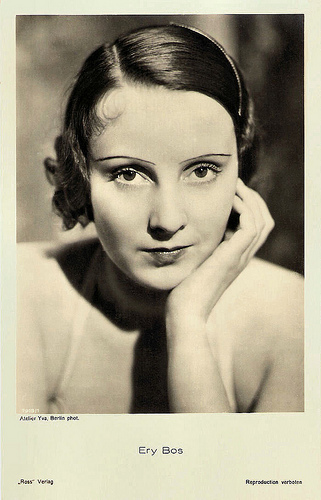
German postcard by Ross Verlag, no. 7919/1, 1932-1933. Photo: Atelier Yva, Berlin.
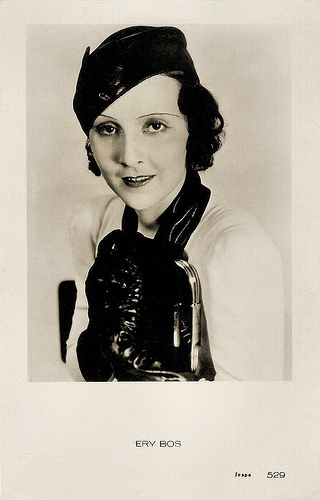
Dutch postcard by JosPe, no. 529.
Escaping the holocaust
In 1933, Ery Bos played parts in Roman einer Nacht/Story of a Night (Carl Boese, 1933) and Der Zarewitsch/The Czarevitch (Victor Janson, 1933) starring Márta Eggerth .
After the Nazis had gained power in 1933, the Jewish actress soon fled the country, escaping the holocaust.
In 1934, her final films Mit dir durch dick und dünn/With you through thick and thin (Frans Seitz, 1934), Du bist entzückend, Rosmarie!/You are adorable, Rosmarie! (Hans von Wolzogen, 1934), Jede Frau hat ein Geheimnis/Every Woman Has a Secret (Max Obal, 1934) with Karin Hardt , and Grüß' mir die Lore noch einmal/Greet Lore again for me (Carl Heinz Wolff, 1934), could be seen in the German cinemas.
Ery Bos married Herbert Grünfeld (1908-1977) and lived as Ery Grünfeld in the US. She would never make another film.
In 2005, Erika Grünfeld died in Chappaqua (some sources say New Castle) in the state of New York at the age of 96.
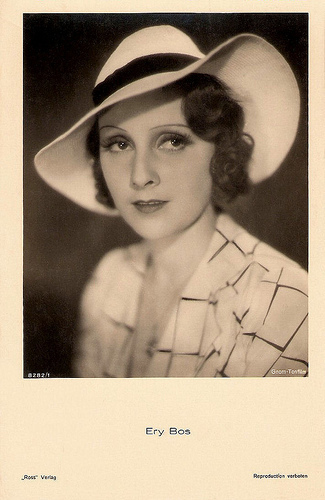
German postcard by Ross Verlag, no. 8282/1, 1933-1934. Photo: Gnom-Tonfilm. Publicity still for Das Lied vom Glück/The Song of Happiness (Carl Boese, 1933). Collection: Egbert Barten.
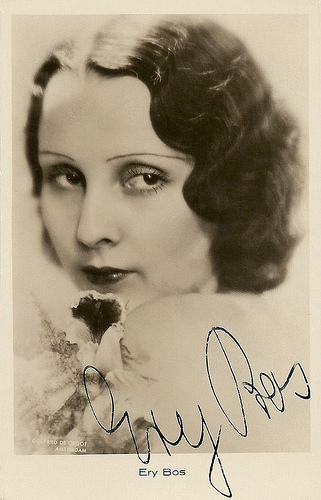
Dutch postcard. Photo: Godfried de Groot , Amsterdam. Collection: Didier Hanson.
Sources: Thomas Staedeli (Cyranos), Rate Your Music, Wikipedia (German), and .

German collectors card by Salem Zigaretten in the series Bunte Filmbilder, no. 269 (in a series of 275). Photo: Dührkoop / Ross Verlag.
Solo Dancer
Erika Bos was born in Berlin, Germany in 1908 (some sources say 1910). She was the daughter of Dutch composer and pianist Coenraad V. Bos.
At the age of 10, she already had dance classes. She first attended public attention as a solo dancer in the 1920s and at 17 she was already a solo dancer in the city of Dortmund.
The beautiful dancer also followed speaking lessons by Ilka Grüning and soon she was spotted by the major German film studio Ufa.
Ery made her film début with Peter Lorre in the crime film Schuß im Morgengrauen/Shot at Dawn (Alfred Zeisler, 1932).
To her other films that year belong Liebe in Uniform/Love in Uniform (Georg Jacoby, 1932) and Unmögliche Liebe/Crown of Thorns (Ery Grünfeld, 1932) in which she appeared as a daughter of Asta Nielsen .

German postcard by Ross Verlag, no. 7919/1, 1932-1933. Photo: Atelier Yva, Berlin.

Dutch postcard by JosPe, no. 529.
Escaping the holocaust
In 1933, Ery Bos played parts in Roman einer Nacht/Story of a Night (Carl Boese, 1933) and Der Zarewitsch/The Czarevitch (Victor Janson, 1933) starring Márta Eggerth .
After the Nazis had gained power in 1933, the Jewish actress soon fled the country, escaping the holocaust.
In 1934, her final films Mit dir durch dick und dünn/With you through thick and thin (Frans Seitz, 1934), Du bist entzückend, Rosmarie!/You are adorable, Rosmarie! (Hans von Wolzogen, 1934), Jede Frau hat ein Geheimnis/Every Woman Has a Secret (Max Obal, 1934) with Karin Hardt , and Grüß' mir die Lore noch einmal/Greet Lore again for me (Carl Heinz Wolff, 1934), could be seen in the German cinemas.
Ery Bos married Herbert Grünfeld (1908-1977) and lived as Ery Grünfeld in the US. She would never make another film.
In 2005, Erika Grünfeld died in Chappaqua (some sources say New Castle) in the state of New York at the age of 96.

German postcard by Ross Verlag, no. 8282/1, 1933-1934. Photo: Gnom-Tonfilm. Publicity still for Das Lied vom Glück/The Song of Happiness (Carl Boese, 1933). Collection: Egbert Barten.

Dutch postcard. Photo: Godfried de Groot , Amsterdam. Collection: Didier Hanson.
Sources: Thomas Staedeli (Cyranos), Rate Your Music, Wikipedia (German), and .
Published on September 24, 2014 23:00
September 23, 2014
Ernst Winar
Today starts the 2014 edition of the Nederlands Film Festival (24 September - 3 October 2014) in Utrecht. During the festival, EFSP presents again the unofficial Dutch Film Star Postcards Festival! We start with little known Dutch actor Ernst Winar (1894-1978), who appeared in 34 films between 1916 and 1955, in The Netherlands and as well in Germany. He was also a film director and made 14 films between 1922 and 1955. Later he was the editor of the first, short films of Paul Verhoeven.
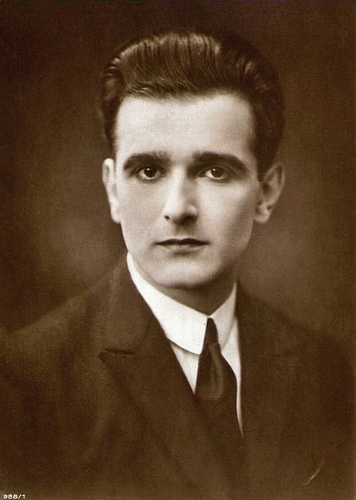
Vintage postcard, no. 988/1.
Jack Of All Trades
Ernst Winar was born as Joseph Wilhelm Carl von Eichhof-Winar from a German family in Leiden, The Netherlands, in 1894.
After finishing school he began an engineering study in Germany, but World War I forced him to break off this studies.
Temporarily exempted from military service, he was employed by the Filmfabriek Hollandia (Film factory Hollandia) in Haarlem as a real Jack of all trades.
At Hollandia, he started as an actor in a small role in the silent film Majoor Frans/Major Francis (Maurits Binger, 1916) with Dutch diva Annie Bos in the lead.
Other silent Dutch films in which he appeared were La renzoni (Maurits Binger, 1916) again starring Annie Bos - the only star of the Dutch silent cinema, the opera film Gloria transita (Johan Gildemeijer, 1917), Ulbo Garvema (Maurits Binger, 1917), De kroon der schande/The Crown of Shame (Maurits Binger, 1917) with Annie Bos and Adelqui Migliar , Toen 't licht verdween/Blind (Maurits Binger, 1918), and Pro domo (Theo Frenkel Sr., 1918) starring the legendary Dutch stage actor Louis Bouwmeester .
In these films, Winar usually appeared in a supporting role or even as an extra.
After the war he tried to gain a foothold as an actor. He played on stage under the name of W. Eikhof at the Casino ensemble in The Hague. He also translated plays by Ferenc Molnar into Dutch, and he continued to appear in films.
Een Carmen van het Noorden/A Carmen of the North (Maurits Binger, 1919) based on the novel by Prosper Mérimée, was a highlight among the films of the Filmfabriek Hollandia. This film featured again the stars Annie Bos and Adelqui Migliar , and was a moderate international success.
Other films in which Winar appeared were De duivel in Amsterdam/The Devil in Amsterdam (Theo Frenkel Sr., 1919) based on Winar's translation of a Molnar play and starring Eduard Verkade as the devil and Louis Bouwmeester as a banker, and Verborgen levens/Fate's Plaything (Maurits Binger, B.E. Doxat-Pratt, 1920).
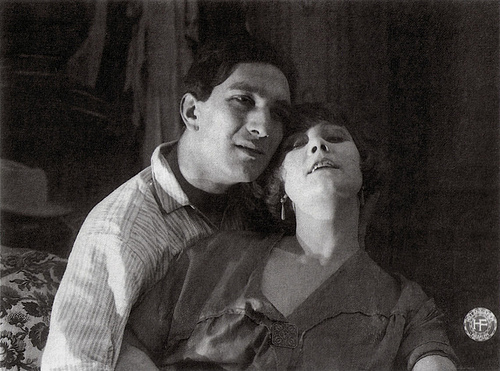
Publicity still for Een Carmen van het Noorden/A Carmen of the North (Maurits Binger, 1919) with Annie Bos and Adelqui Migliar . Source: Immagine. Nuova Serie N. 16, 1990-1991.
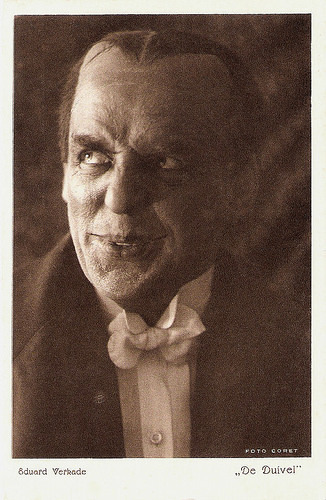
Dutch postcard. Photo: Coret, Den Haag. Picture of Eduard Verkade as the Devil in the stage play De duivel (Az Ördög/The Devil) by Ferenc Molnár.
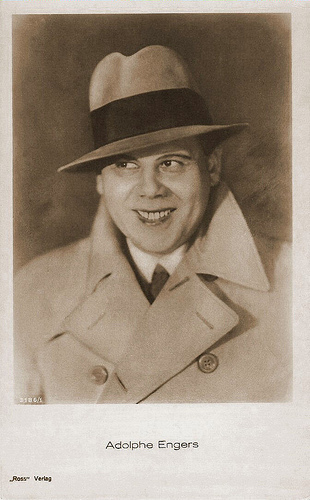
Adolphe Engers . German postcard by Ross Verlag, no. 3186/1, 1928-1929. Collection: Egbert Barten.
Sought-after Actor
In the 1920s Ernst Winar ventured into Germany as an actor but he also took the opportunity to direct several films.
As an actor, he got his first major role in Die Benefizvorstellung der Vier Teufel/The benefit performance of the four devils (1920) by Danish director Anders Wilhelm Sandberg. The film was a success and numerous films followed.
The now sought-after actor appeared in such films as Der Liebling der Frauen/The favorite of the women (Carl Wilhelm, 1921) with the then largely unknown Maly Delschaft in the lead role, Der unsichtbare Gast/The invisible guest (Friedrich Zelnik, 1921), and Wettlauf ums Glück/Race to happiness (Bruno Ziener, 1923). In this love story located in Tibet, Winar starred alongside his future wife and frequent film partner, British actress Colette Brettel.
From 1921 on, Winar was also active as a director. First he was responsible for three episodes of the Terra series Flappy with Adolphe Engers in the lead role.
In 1922, he directed his first feature film, the crime film Der Mann im Hintergrund/The man in the background, but the film was released only after several changes in October 1924.
In the following four years Winar mainly worked as an actor. He played supporting roles in the comedy Komödie des Herzens/The Comedy of the Heart (Rochus Gliese, 1924) with Lil Dagover , in Die Millionenkompagnie/The Millions Company (Fred Sauer, 1925) with Olga Tschechova , and the successful comedy Die Kleine vom Bummel/The little girl from Bummel (Richard Eichberg, 1925) starring Lilian Harvey .
In 1923, he also taught directing at the Terra film school in Berlin.
His later German films as a director included Wochenend wider Willen/Weekend Against Sake (1927) starring Ossi Oswalda , Das Haus am Krögel/The House on Krögel (1927), Der Neffe aus Amerika/The Cousin From America (1927), Wochendbraut/Weekend Bride (1928) starring Anny Ondra , and Der Hafenbaron/The Port Baron (1928).
Most of these films featured Colette Brettel. With his film § 182 minderjährig/Paragraph 182 – Minor of Age (1927) he got three times in conflict with the censors.
With the advent of the sound film era his acting period in Germany ended. In 1930, he appeared for the last time in a German production, the Luis Trenker film Die heiligen drei Brunnen/The three holy wells (Mario Bonnard, 1930).

Dutch postcard by M.B. & Z. (M. Bonnist & Zonen, Amsterdam). Photo: Dick van Maarseveen, Den Haag / Nationaal Film. Publicity still for Op stap/On the Move (Ernst Winar, 1935) with Frits van Dongen and Fien de la Mar.

Dutch postcard by M.B. & Z. (M. Bonnist & Zonen, Amsterdam). Photo: Dick van Maarseveen, Den Haag / Nationaal Film. Publicity still of Fien(tje) de la Mar in Op stap/On the Move (Ernst Winar, 1935).
On the Road
In 1932 Ernst Winar returned to the Netherlands. He made the short sound film Hollandsch Hollywood/Dutch Hollywood (1934) for which revue star Fien de la Mar sang the title song, announcing a new Dutch film industry.
In 1935 Winar and Fien de la Mar worked together again on the musical Op Stap/On the Road (Ernst Winar, 1935) which also featured revue stars Louis and Heintje Davids and Adolphe Engers , who was also back from Berlin.
For the Cinetone studios Winar co-directed the film De Kribbebijter/The Double-Patch (1935) with German émigré director Hermann Kosterlitz aka Henry Koster as his co-director. This successful comedy starred Cor Ruys and Frits van Dongen , who later became a well known film actor in Berlin and Hollywood under the name of Philip Dorn.
Winar was one of the few Dutch directors who had mastered the trade of film directing and he would have a major impact in the 1940s and 1950s, when the appearance of a Dutch feature film was rare.
During the war he presented De laatste dagen van een eiland/The Last days of an island (Ernst Winar, 1942) with Max Croiset , based on a story of Klaas Norel. The film was already recorded in 1938 and privately screened later that year, but only in 1942 publicly, probably because only a few films were approved by the German occupiers. It was the second film produced by the Dutch Christian Film Centre, but during the war this organization was already shut down.
After the Second World War, Winar’s interest shifted to children's films, such as Dik Trom en zijn dorpsgenoten/Dik Trom and his fellow villagers (Ernst Winar, 1947) with his former director Theo Frenkel Sr. in one of the supporting roles, and Vier jongens en een jeep/Four guys and a jeep (Ernst Winar, 1955) with Sylvain Poons .
The latter film was his last feature as a director and he also made his final film appearance in it.
During the 1960s, Winar escorted the young filmmaker Paul Verhoeven as the editor of the short films Een Hagedis teveel/A Lizard Too Much (Paul Verhoeven, 1960), De Lifters/The Hitchhikers (Paul Verhoeven, 1962), Feest!/Party! (Paul Verhoeven, 1963) and Het Korps Mariniers/The Royal Dutch Marine Corps (Paul Verhoeven, 1965).
He also worked for the Foundation Film en Wetenschap (Film and Science) in Utrecht. In 1976 he finally appeared one more time in a small role in the TV film Volk en vaderliefde/People and Father Love (Wim T. Schippers, 1976) based on the story by Herodotus.
Ernst Winar died in 1978 in Leiden, aged 83.
Final scene from Op Stap/On the Road (Ernst Winar, 1935) with Fien de la Mar and a dozen pianos. Source: Captainvontrapp (YouTube).
Sources: Fred van Doorn/Peter van Bueren (Filmbijlage VN 1975), Deutsches Filminstitut (German), Wikipedia and .

Vintage postcard, no. 988/1.
Jack Of All Trades
Ernst Winar was born as Joseph Wilhelm Carl von Eichhof-Winar from a German family in Leiden, The Netherlands, in 1894.
After finishing school he began an engineering study in Germany, but World War I forced him to break off this studies.
Temporarily exempted from military service, he was employed by the Filmfabriek Hollandia (Film factory Hollandia) in Haarlem as a real Jack of all trades.
At Hollandia, he started as an actor in a small role in the silent film Majoor Frans/Major Francis (Maurits Binger, 1916) with Dutch diva Annie Bos in the lead.
Other silent Dutch films in which he appeared were La renzoni (Maurits Binger, 1916) again starring Annie Bos - the only star of the Dutch silent cinema, the opera film Gloria transita (Johan Gildemeijer, 1917), Ulbo Garvema (Maurits Binger, 1917), De kroon der schande/The Crown of Shame (Maurits Binger, 1917) with Annie Bos and Adelqui Migliar , Toen 't licht verdween/Blind (Maurits Binger, 1918), and Pro domo (Theo Frenkel Sr., 1918) starring the legendary Dutch stage actor Louis Bouwmeester .
In these films, Winar usually appeared in a supporting role or even as an extra.
After the war he tried to gain a foothold as an actor. He played on stage under the name of W. Eikhof at the Casino ensemble in The Hague. He also translated plays by Ferenc Molnar into Dutch, and he continued to appear in films.
Een Carmen van het Noorden/A Carmen of the North (Maurits Binger, 1919) based on the novel by Prosper Mérimée, was a highlight among the films of the Filmfabriek Hollandia. This film featured again the stars Annie Bos and Adelqui Migliar , and was a moderate international success.
Other films in which Winar appeared were De duivel in Amsterdam/The Devil in Amsterdam (Theo Frenkel Sr., 1919) based on Winar's translation of a Molnar play and starring Eduard Verkade as the devil and Louis Bouwmeester as a banker, and Verborgen levens/Fate's Plaything (Maurits Binger, B.E. Doxat-Pratt, 1920).

Publicity still for Een Carmen van het Noorden/A Carmen of the North (Maurits Binger, 1919) with Annie Bos and Adelqui Migliar . Source: Immagine. Nuova Serie N. 16, 1990-1991.

Dutch postcard. Photo: Coret, Den Haag. Picture of Eduard Verkade as the Devil in the stage play De duivel (Az Ördög/The Devil) by Ferenc Molnár.

Adolphe Engers . German postcard by Ross Verlag, no. 3186/1, 1928-1929. Collection: Egbert Barten.
Sought-after Actor
In the 1920s Ernst Winar ventured into Germany as an actor but he also took the opportunity to direct several films.
As an actor, he got his first major role in Die Benefizvorstellung der Vier Teufel/The benefit performance of the four devils (1920) by Danish director Anders Wilhelm Sandberg. The film was a success and numerous films followed.
The now sought-after actor appeared in such films as Der Liebling der Frauen/The favorite of the women (Carl Wilhelm, 1921) with the then largely unknown Maly Delschaft in the lead role, Der unsichtbare Gast/The invisible guest (Friedrich Zelnik, 1921), and Wettlauf ums Glück/Race to happiness (Bruno Ziener, 1923). In this love story located in Tibet, Winar starred alongside his future wife and frequent film partner, British actress Colette Brettel.
From 1921 on, Winar was also active as a director. First he was responsible for three episodes of the Terra series Flappy with Adolphe Engers in the lead role.
In 1922, he directed his first feature film, the crime film Der Mann im Hintergrund/The man in the background, but the film was released only after several changes in October 1924.
In the following four years Winar mainly worked as an actor. He played supporting roles in the comedy Komödie des Herzens/The Comedy of the Heart (Rochus Gliese, 1924) with Lil Dagover , in Die Millionenkompagnie/The Millions Company (Fred Sauer, 1925) with Olga Tschechova , and the successful comedy Die Kleine vom Bummel/The little girl from Bummel (Richard Eichberg, 1925) starring Lilian Harvey .
In 1923, he also taught directing at the Terra film school in Berlin.
His later German films as a director included Wochenend wider Willen/Weekend Against Sake (1927) starring Ossi Oswalda , Das Haus am Krögel/The House on Krögel (1927), Der Neffe aus Amerika/The Cousin From America (1927), Wochendbraut/Weekend Bride (1928) starring Anny Ondra , and Der Hafenbaron/The Port Baron (1928).
Most of these films featured Colette Brettel. With his film § 182 minderjährig/Paragraph 182 – Minor of Age (1927) he got three times in conflict with the censors.
With the advent of the sound film era his acting period in Germany ended. In 1930, he appeared for the last time in a German production, the Luis Trenker film Die heiligen drei Brunnen/The three holy wells (Mario Bonnard, 1930).

Dutch postcard by M.B. & Z. (M. Bonnist & Zonen, Amsterdam). Photo: Dick van Maarseveen, Den Haag / Nationaal Film. Publicity still for Op stap/On the Move (Ernst Winar, 1935) with Frits van Dongen and Fien de la Mar.

Dutch postcard by M.B. & Z. (M. Bonnist & Zonen, Amsterdam). Photo: Dick van Maarseveen, Den Haag / Nationaal Film. Publicity still of Fien(tje) de la Mar in Op stap/On the Move (Ernst Winar, 1935).
On the Road
In 1932 Ernst Winar returned to the Netherlands. He made the short sound film Hollandsch Hollywood/Dutch Hollywood (1934) for which revue star Fien de la Mar sang the title song, announcing a new Dutch film industry.
In 1935 Winar and Fien de la Mar worked together again on the musical Op Stap/On the Road (Ernst Winar, 1935) which also featured revue stars Louis and Heintje Davids and Adolphe Engers , who was also back from Berlin.
For the Cinetone studios Winar co-directed the film De Kribbebijter/The Double-Patch (1935) with German émigré director Hermann Kosterlitz aka Henry Koster as his co-director. This successful comedy starred Cor Ruys and Frits van Dongen , who later became a well known film actor in Berlin and Hollywood under the name of Philip Dorn.
Winar was one of the few Dutch directors who had mastered the trade of film directing and he would have a major impact in the 1940s and 1950s, when the appearance of a Dutch feature film was rare.
During the war he presented De laatste dagen van een eiland/The Last days of an island (Ernst Winar, 1942) with Max Croiset , based on a story of Klaas Norel. The film was already recorded in 1938 and privately screened later that year, but only in 1942 publicly, probably because only a few films were approved by the German occupiers. It was the second film produced by the Dutch Christian Film Centre, but during the war this organization was already shut down.
After the Second World War, Winar’s interest shifted to children's films, such as Dik Trom en zijn dorpsgenoten/Dik Trom and his fellow villagers (Ernst Winar, 1947) with his former director Theo Frenkel Sr. in one of the supporting roles, and Vier jongens en een jeep/Four guys and a jeep (Ernst Winar, 1955) with Sylvain Poons .
The latter film was his last feature as a director and he also made his final film appearance in it.
During the 1960s, Winar escorted the young filmmaker Paul Verhoeven as the editor of the short films Een Hagedis teveel/A Lizard Too Much (Paul Verhoeven, 1960), De Lifters/The Hitchhikers (Paul Verhoeven, 1962), Feest!/Party! (Paul Verhoeven, 1963) and Het Korps Mariniers/The Royal Dutch Marine Corps (Paul Verhoeven, 1965).
He also worked for the Foundation Film en Wetenschap (Film and Science) in Utrecht. In 1976 he finally appeared one more time in a small role in the TV film Volk en vaderliefde/People and Father Love (Wim T. Schippers, 1976) based on the story by Herodotus.
Ernst Winar died in 1978 in Leiden, aged 83.
Final scene from Op Stap/On the Road (Ernst Winar, 1935) with Fien de la Mar and a dozen pianos. Source: Captainvontrapp (YouTube).
Sources: Fred van Doorn/Peter van Bueren (Filmbijlage VN 1975), Deutsches Filminstitut (German), Wikipedia and .
Published on September 23, 2014 23:00
September 22, 2014
I.M. Peter von Bagh (1943-2014)
Yesterday, I heard that Finnish film historian and director Peter von Bagh passed away on 17 September. He was 71. Although I never saw one of his films, I loved his work as the artistic director of Il Cinema Ritrovato in Bologna. Followers of this blog know that I am a fan of this festival full of recovered film treasures and try to visit and post about it every year. Peter von Bagh introduced many of the films in Bologna. With his passionate, inspiring and informative speeches, he turned every screening into a special event. As a tribute, a post with 10 programme cards of Il Cinema Rotrovate.
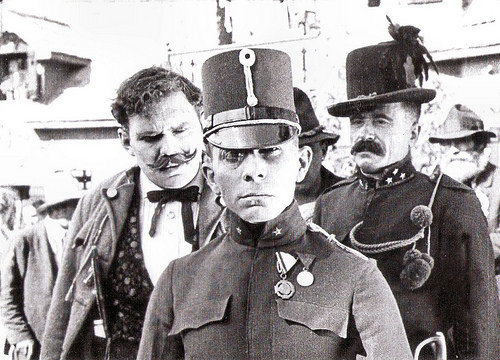
Italian programme card for Il Cinema Ritrovata 2007. Photo: publicity still for Blind Husbands (Erich von Stroheim, 1919) with Erich von Stroheim .
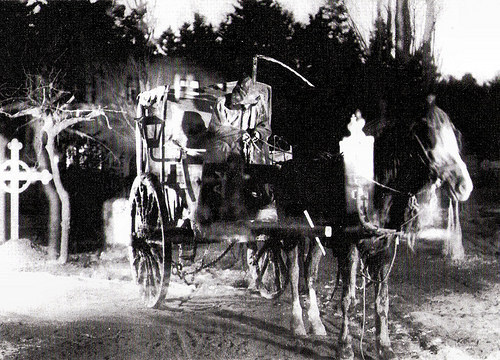
Italian programme card for Il Cinema Ritrovata 2003. Photo: publicity still for Körkarlen/The Phantom Carriage ( Victor Sjöström , 1921).
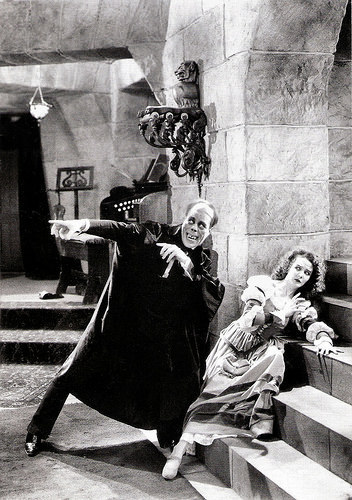
Italian programme card for Il Cinema Ritrovata 2011. Photo: publicity still for Phantom of the Opera (Rupert Julian, 1925) with Lon Chaney and Mary Philbin.
More than Il Cinema Ritrovato
Since 2001 Peter von Bagh worked as the Artistic Director of Il Cinema Ritrovato in Bologna, Italy. The Festival specializes in 'recovered' films, previously believed lost or unknown, silent films and restored prints.
The screen annually erected in Piazza Maggiore in Bologna at the turn of June/July attracts an audience of thousands of spectators. The Festival audience is a mix of local and international cinephiles and specialists of the field.
But outside of Bologna, Von Bagh also had an impressive résumé. Kari Peter Conrad von Bagh (1943-2014) produced approximately 40 non-fiction books, mostly on cinema, and some 60 films for both cinema and television.
The connecting thought in his own films is the history of everyday Finnish life: images of details conveying something of what the life of the Finns has been like.
The films Vuosi 1952/The Year 1952 (1980), Viimeinen kesä 1944/The Last Summer 1944 (1992), and Splinters – A Century Of An Artistic Family (2011) provide a magnifying glass for peeking at history, defined by a certain moment in time, location, or an artistic family.
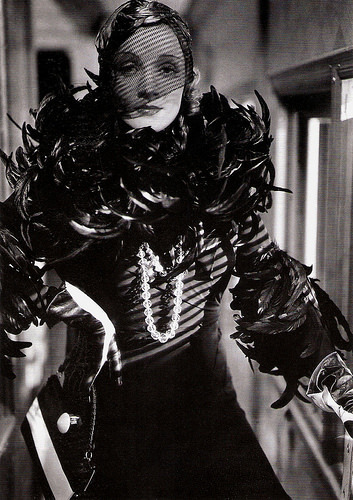
Italian programme card for Il Cinema Ritrovata 2008. Photo: publicity still for Shanghai Express (Josef von Sternberg, 1932) with Marlene Dietrich .
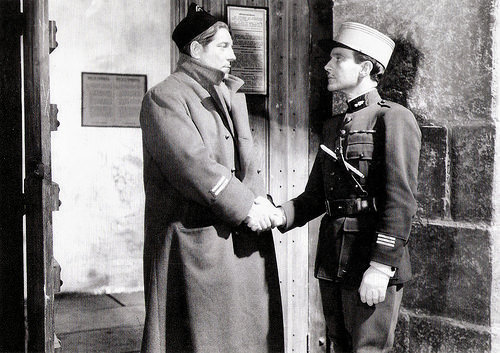
Italian programme card for Il Cinema Ritrovata 2012. Photo: publicity still for La Grande Illusion (Jean Renoir, 1937) with Jean Gabin and Pierre Fresnay .
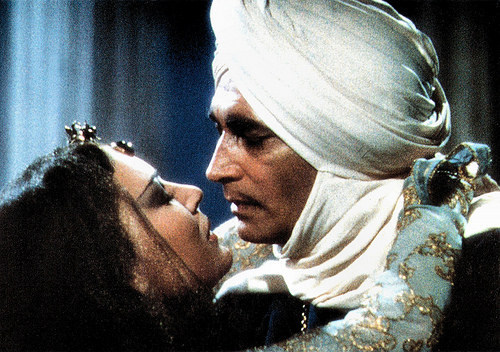
Italian programme card for Il Cinema Ritrovata 2011. Photo: publicity still for The Thief of Bagdad (Ludwig Berger, Michael Powell, Tim Whelan, Alexander Korda, Zoltan Korda, William Cameron Menzies, 1940) with June Deprez and Conrad Veidt .
And as always witty - very, very witty
Peter von Bagh also compiled a textbook on cinema, Salainen muisti (2009), to be used in schools. He taught and lectured at several schools and universities, e.g. as Professor of Film History at Aalto University since 2001, and he worked as the head of the Finnish Film Archive.
Other principal works of Von Bagh's production include his international breakthrough films Helsinki, Forever (2008) and Sodankylä, Forever (2010–2011).
His television series and book Song of Finland (2003/2007), the story of art in Finland during the era of independence, was awarded a Finlandia Prize for nonfiction. Another book, Aki Kaurismäki, has been translated into French, Italian, Swedish, Japanese and German.
Von Bagh was the editor-in-chief of Filmihullu magazine and in 1986, he was the co-founder of the Midnight Sun Festival in Sodankylä, with the famous Finnish filmmaking brothers Aki and Mika Kaurismäki. The festival, known for its no-VIP stance, brought directors such as Francis Ford Coppola and Terry Gilliam to Lapland for the event.
In 2004, he was a member of the jury of the 2004 Cannes Film Festival. His own films were also screened at prestigious international festivals, including the Rotterdam International Film Festival and Festival Internacional de Cine Idependente in Buenos Aires in 2012, and at the Tromsø International Film Festival in 2013.
In July, I last saw and heard Peter van Bagh when he interviewed Richard Lester on the stage at the Piazza Maggoiore. It was an introduction to the screening of the final film of the festival, A Hard Day's Night (Richard Lester, 1964) with The Beatles . Although he looked frail, Von Bagh was in excellent form and his interview with Lester was refreshingly compact and passionate, inspiring and informative. And as always witty - very, very witty.
Mr. van Bagh, we will miss you.
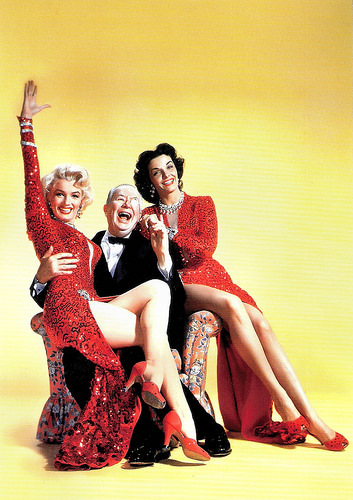
Italian programme card for Il Cinema Ritrovata 2011. Photo: publicity still for Gentlemen prefer blondes (Howard Hawks, 1953) with Marilyn Monroe, Charles Coburn and Jane Russell.
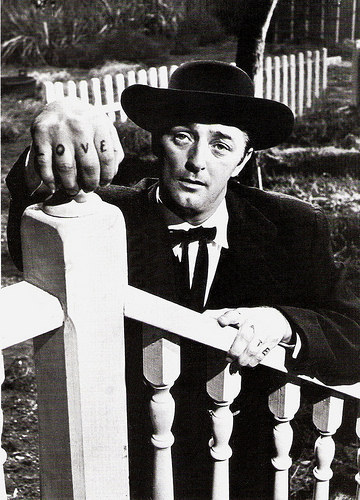
Italian programme card for Il Cinema Ritrovata 2003. Photo: publicity still for The Night of the Hunter (Charles Laughton, 1955) with Robert Mitchum.
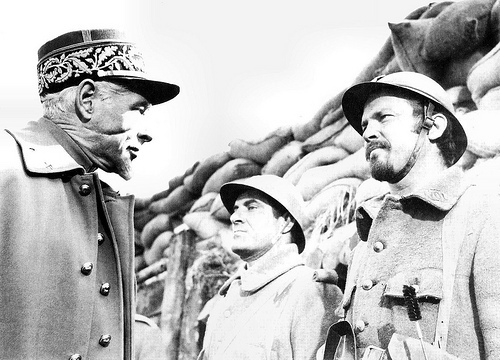
Italian programme card for Il Cinema Ritrovata 2005. Photo: publicity still for Paths of Glory (Stanley Kubrick, 1957) with George Macready, Joe Turkel and Ralph Meeker.
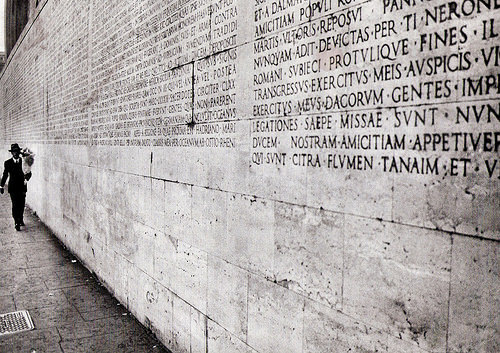
Italian programme card for Il Cinema Ritrovata 2011. Photo: publicity still for Il Conformista (Bernardo Bertolucci, 1970) with Jean-Louis Trintignant .
Source: Yle News and Wikipedia.

Italian programme card for Il Cinema Ritrovata 2007. Photo: publicity still for Blind Husbands (Erich von Stroheim, 1919) with Erich von Stroheim .

Italian programme card for Il Cinema Ritrovata 2003. Photo: publicity still for Körkarlen/The Phantom Carriage ( Victor Sjöström , 1921).

Italian programme card for Il Cinema Ritrovata 2011. Photo: publicity still for Phantom of the Opera (Rupert Julian, 1925) with Lon Chaney and Mary Philbin.
More than Il Cinema Ritrovato
Since 2001 Peter von Bagh worked as the Artistic Director of Il Cinema Ritrovato in Bologna, Italy. The Festival specializes in 'recovered' films, previously believed lost or unknown, silent films and restored prints.
The screen annually erected in Piazza Maggiore in Bologna at the turn of June/July attracts an audience of thousands of spectators. The Festival audience is a mix of local and international cinephiles and specialists of the field.
But outside of Bologna, Von Bagh also had an impressive résumé. Kari Peter Conrad von Bagh (1943-2014) produced approximately 40 non-fiction books, mostly on cinema, and some 60 films for both cinema and television.
The connecting thought in his own films is the history of everyday Finnish life: images of details conveying something of what the life of the Finns has been like.
The films Vuosi 1952/The Year 1952 (1980), Viimeinen kesä 1944/The Last Summer 1944 (1992), and Splinters – A Century Of An Artistic Family (2011) provide a magnifying glass for peeking at history, defined by a certain moment in time, location, or an artistic family.

Italian programme card for Il Cinema Ritrovata 2008. Photo: publicity still for Shanghai Express (Josef von Sternberg, 1932) with Marlene Dietrich .

Italian programme card for Il Cinema Ritrovata 2012. Photo: publicity still for La Grande Illusion (Jean Renoir, 1937) with Jean Gabin and Pierre Fresnay .

Italian programme card for Il Cinema Ritrovata 2011. Photo: publicity still for The Thief of Bagdad (Ludwig Berger, Michael Powell, Tim Whelan, Alexander Korda, Zoltan Korda, William Cameron Menzies, 1940) with June Deprez and Conrad Veidt .
And as always witty - very, very witty
Peter von Bagh also compiled a textbook on cinema, Salainen muisti (2009), to be used in schools. He taught and lectured at several schools and universities, e.g. as Professor of Film History at Aalto University since 2001, and he worked as the head of the Finnish Film Archive.
Other principal works of Von Bagh's production include his international breakthrough films Helsinki, Forever (2008) and Sodankylä, Forever (2010–2011).
His television series and book Song of Finland (2003/2007), the story of art in Finland during the era of independence, was awarded a Finlandia Prize for nonfiction. Another book, Aki Kaurismäki, has been translated into French, Italian, Swedish, Japanese and German.
Von Bagh was the editor-in-chief of Filmihullu magazine and in 1986, he was the co-founder of the Midnight Sun Festival in Sodankylä, with the famous Finnish filmmaking brothers Aki and Mika Kaurismäki. The festival, known for its no-VIP stance, brought directors such as Francis Ford Coppola and Terry Gilliam to Lapland for the event.
In 2004, he was a member of the jury of the 2004 Cannes Film Festival. His own films were also screened at prestigious international festivals, including the Rotterdam International Film Festival and Festival Internacional de Cine Idependente in Buenos Aires in 2012, and at the Tromsø International Film Festival in 2013.
In July, I last saw and heard Peter van Bagh when he interviewed Richard Lester on the stage at the Piazza Maggoiore. It was an introduction to the screening of the final film of the festival, A Hard Day's Night (Richard Lester, 1964) with The Beatles . Although he looked frail, Von Bagh was in excellent form and his interview with Lester was refreshingly compact and passionate, inspiring and informative. And as always witty - very, very witty.
Mr. van Bagh, we will miss you.

Italian programme card for Il Cinema Ritrovata 2011. Photo: publicity still for Gentlemen prefer blondes (Howard Hawks, 1953) with Marilyn Monroe, Charles Coburn and Jane Russell.

Italian programme card for Il Cinema Ritrovata 2003. Photo: publicity still for The Night of the Hunter (Charles Laughton, 1955) with Robert Mitchum.

Italian programme card for Il Cinema Ritrovata 2005. Photo: publicity still for Paths of Glory (Stanley Kubrick, 1957) with George Macready, Joe Turkel and Ralph Meeker.

Italian programme card for Il Cinema Ritrovata 2011. Photo: publicity still for Il Conformista (Bernardo Bertolucci, 1970) with Jean-Louis Trintignant .
Source: Yle News and Wikipedia.
Published on September 22, 2014 22:00
Paul van Yperen's Blog
- Paul van Yperen's profile
- 13 followers
Paul van Yperen isn't a Goodreads Author
(yet),
but they
do have a blog,
so here are some recent posts imported from
their feed.



